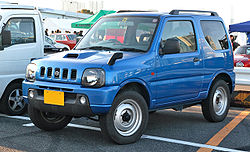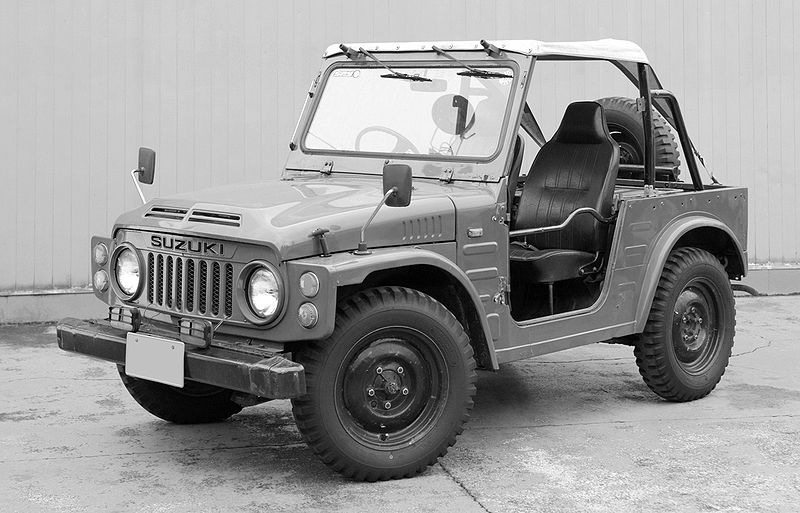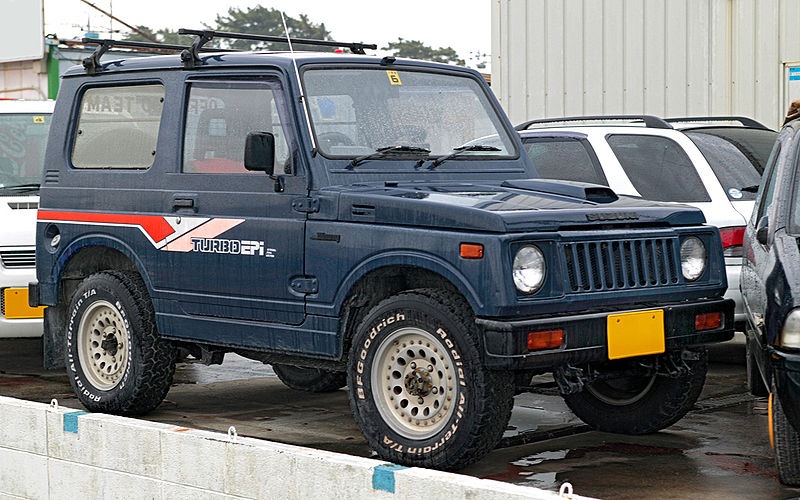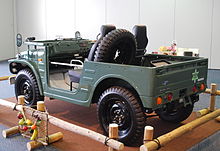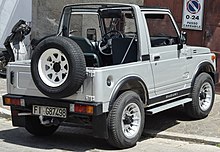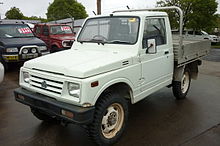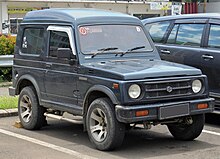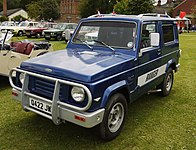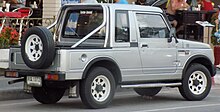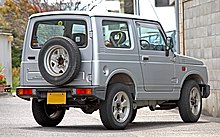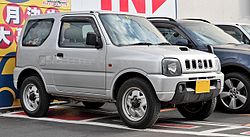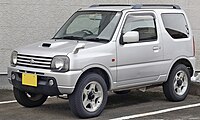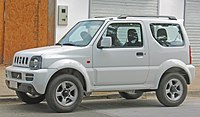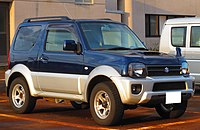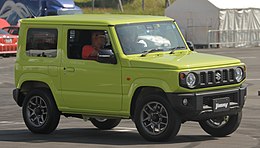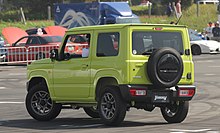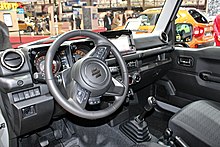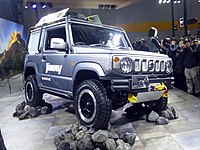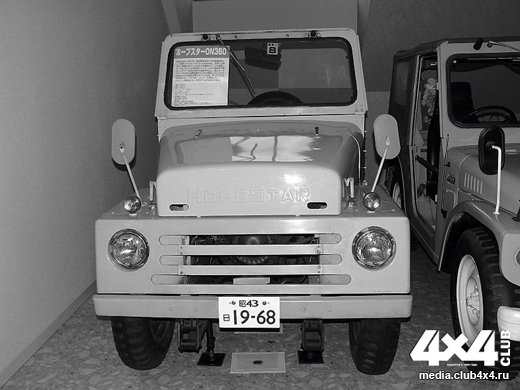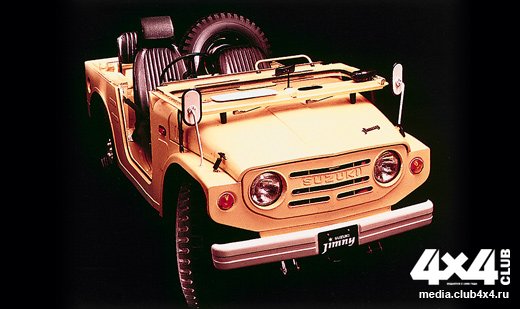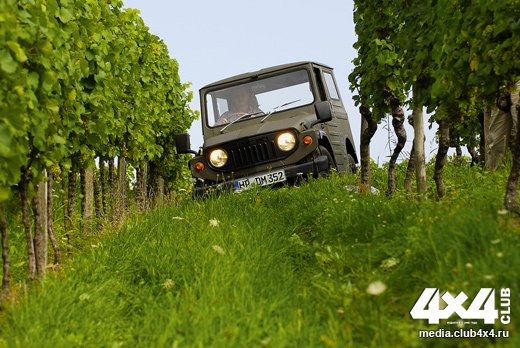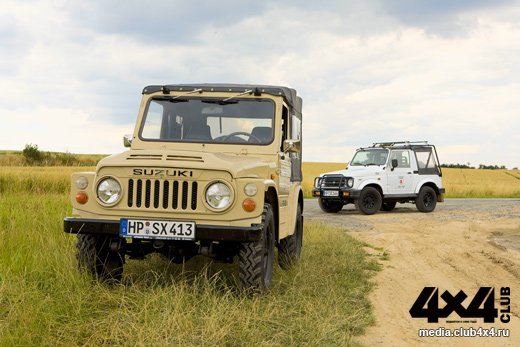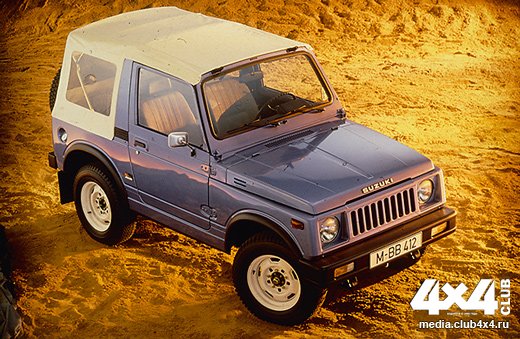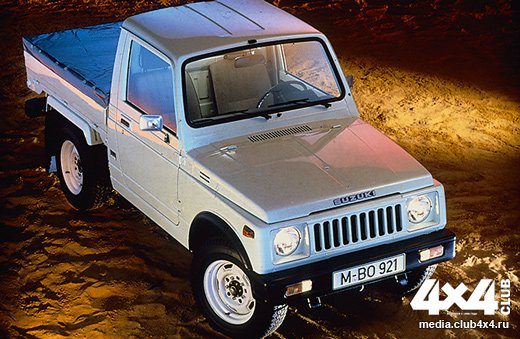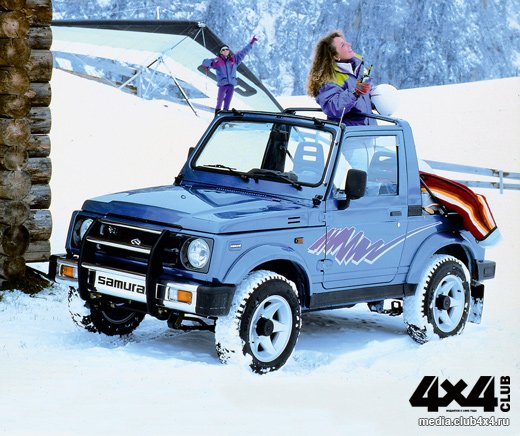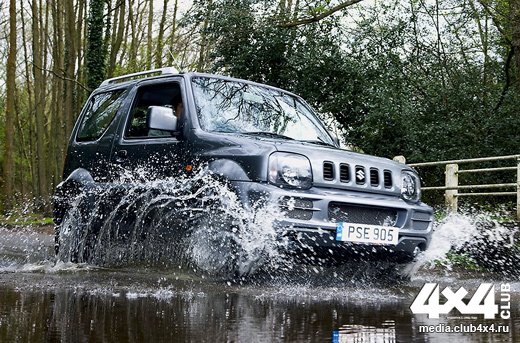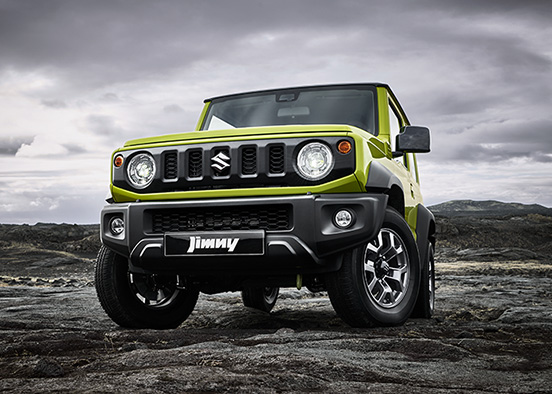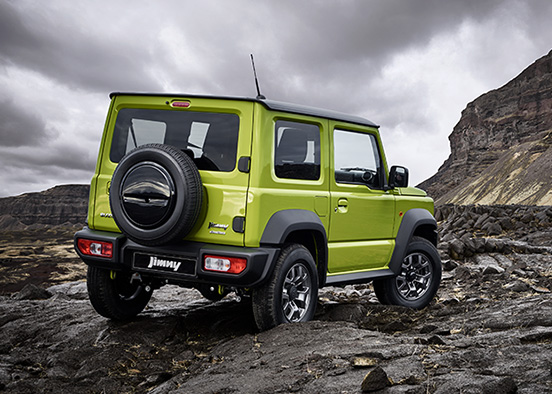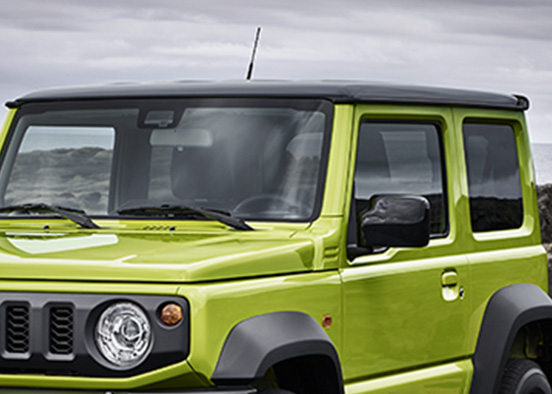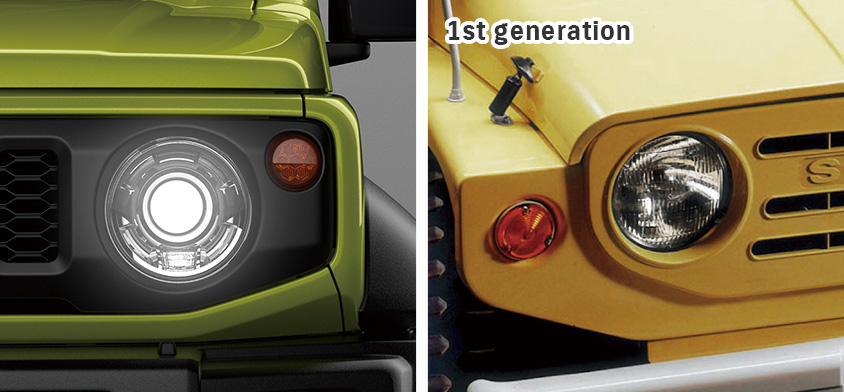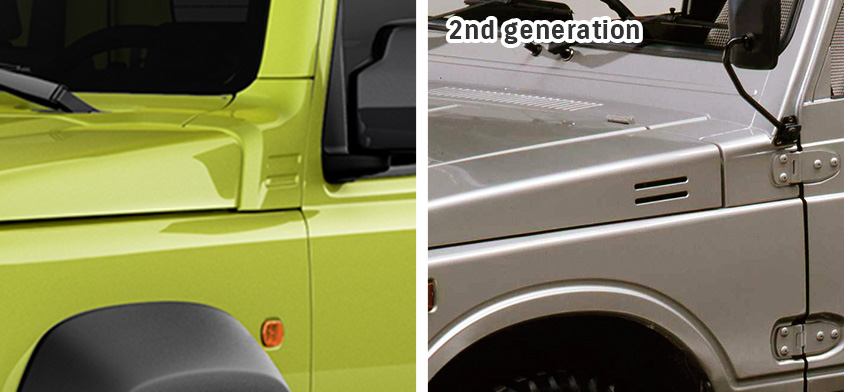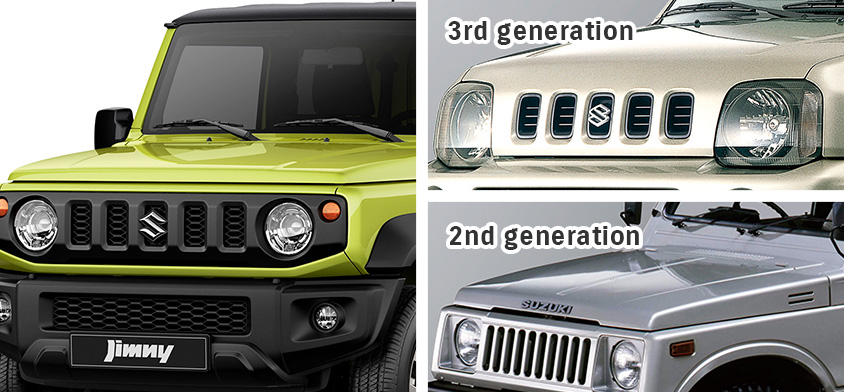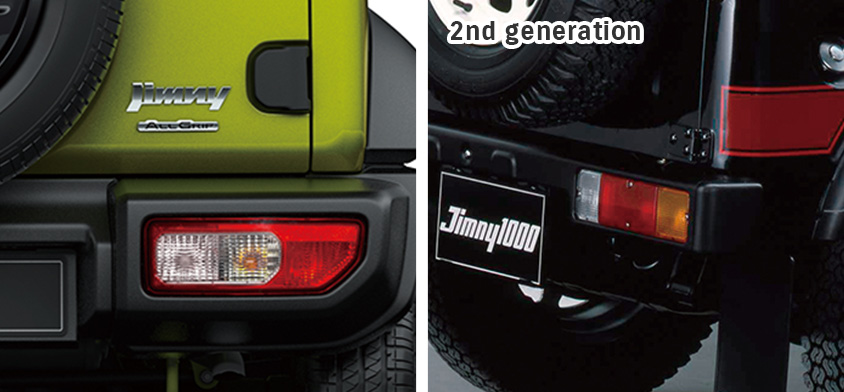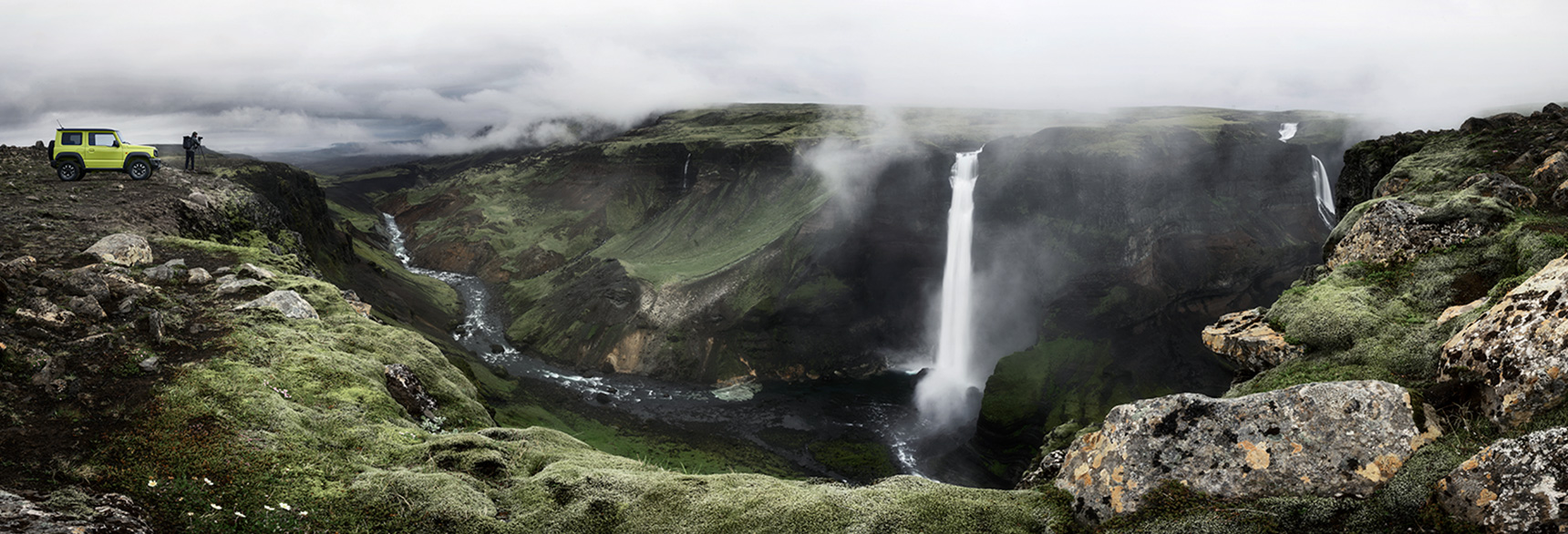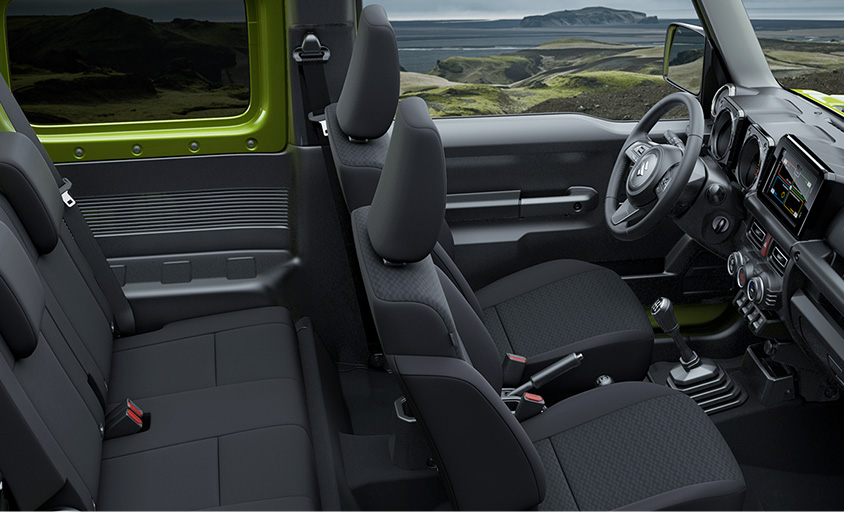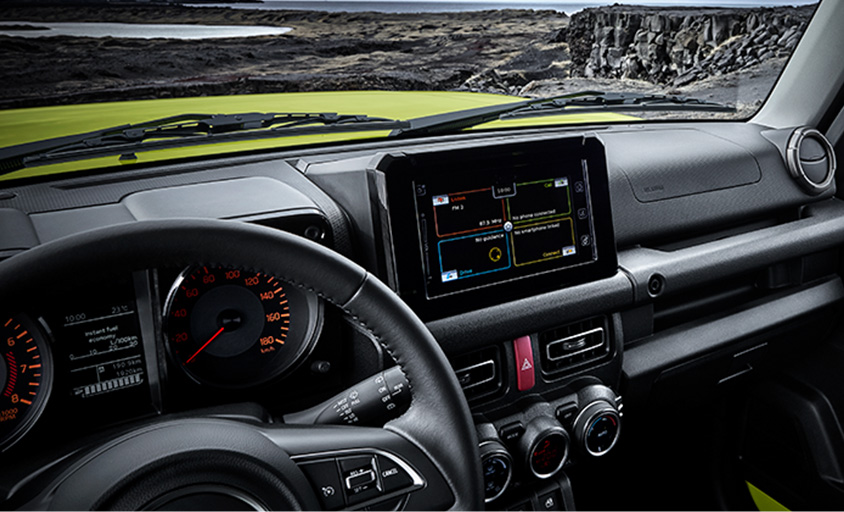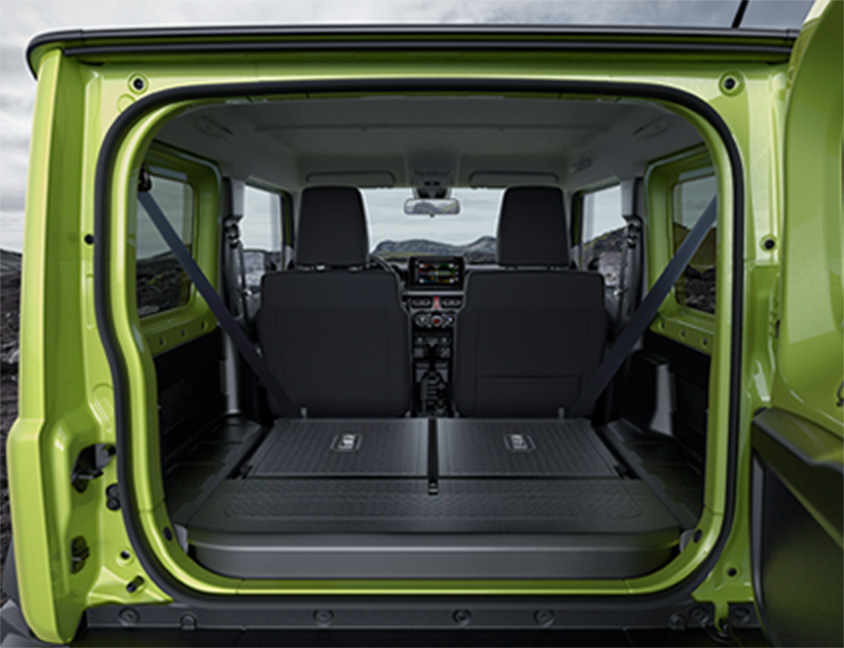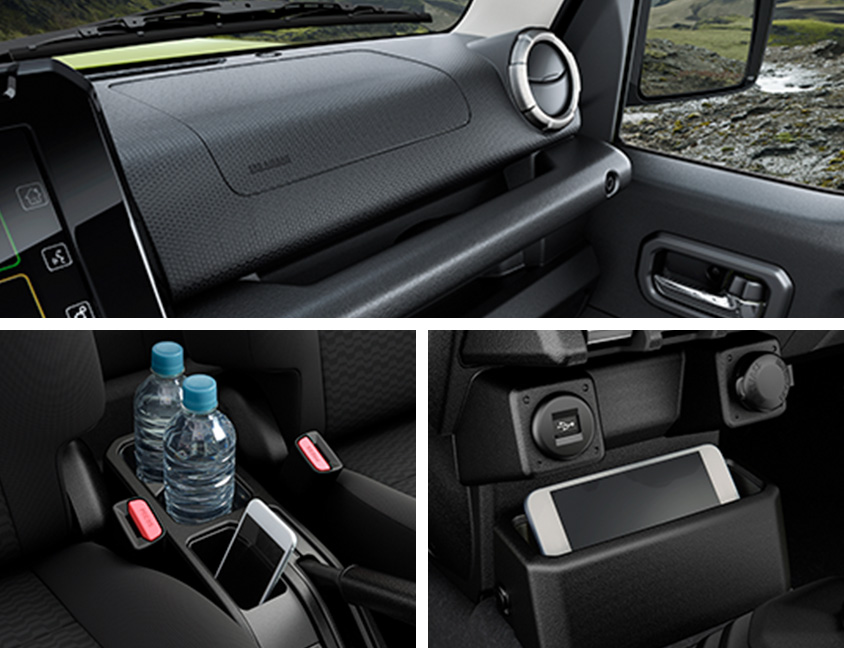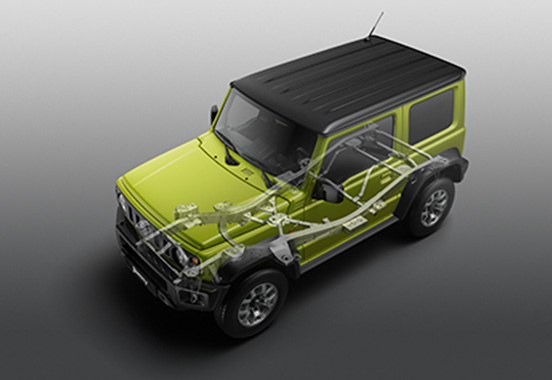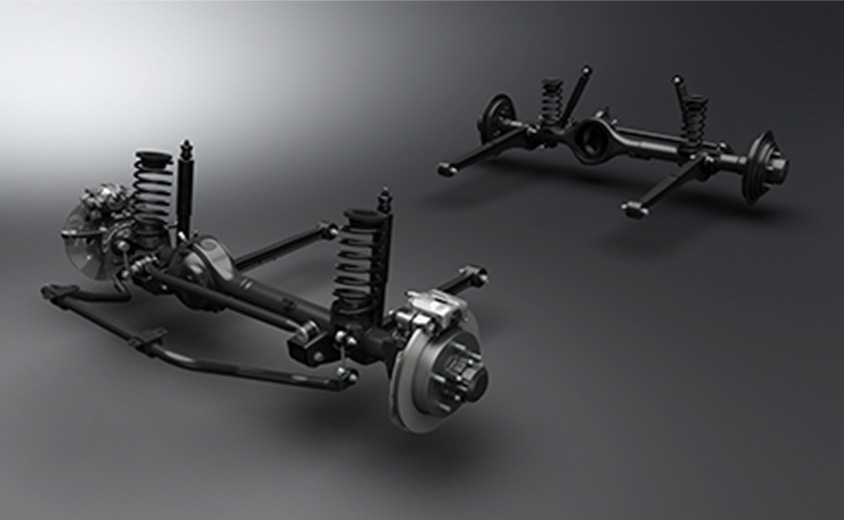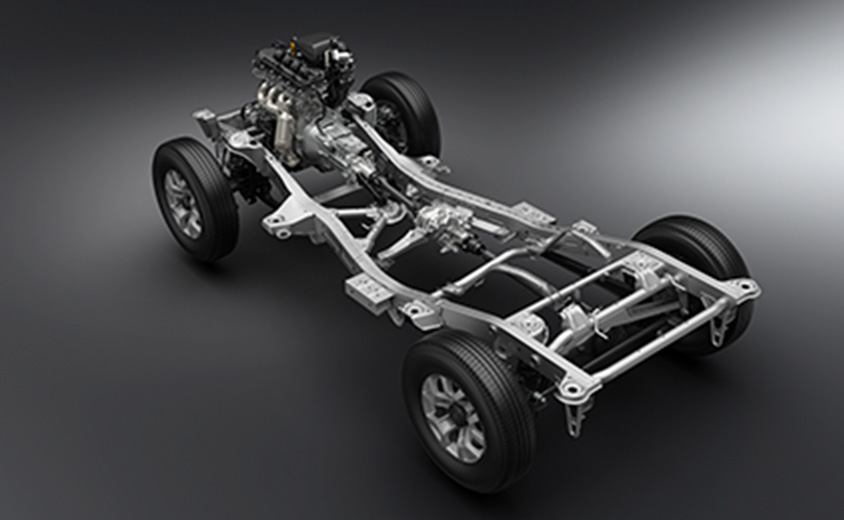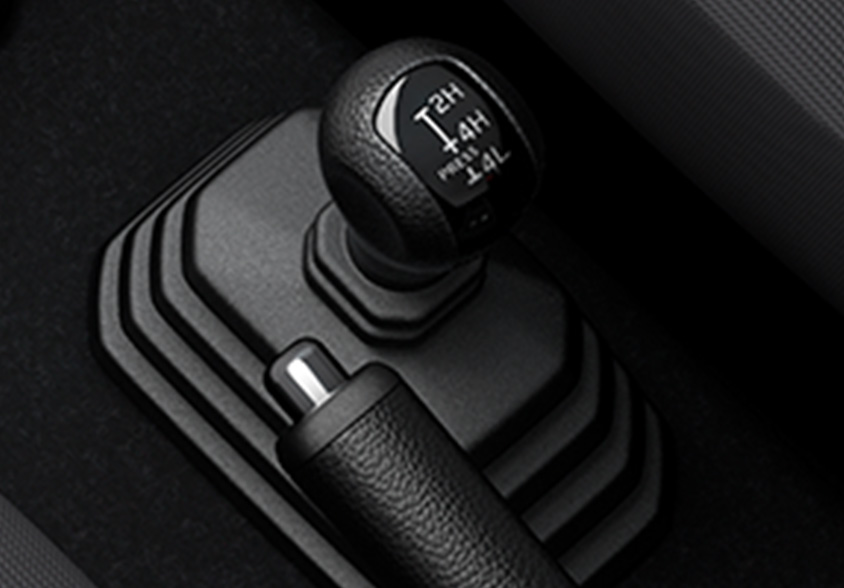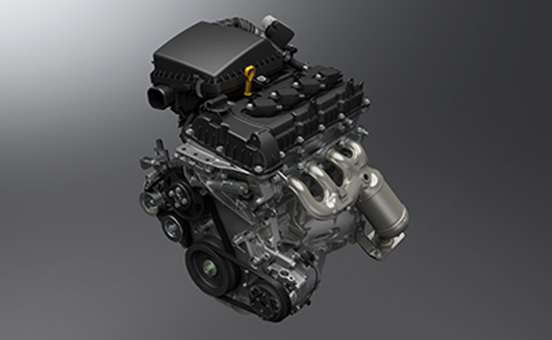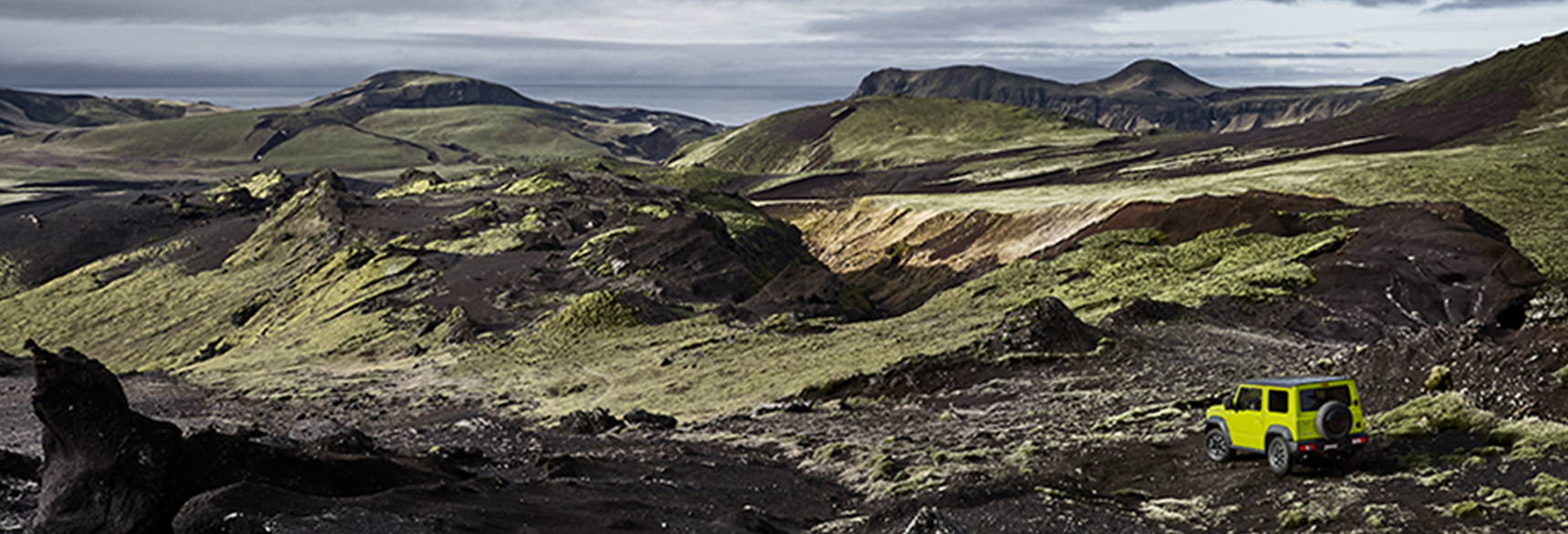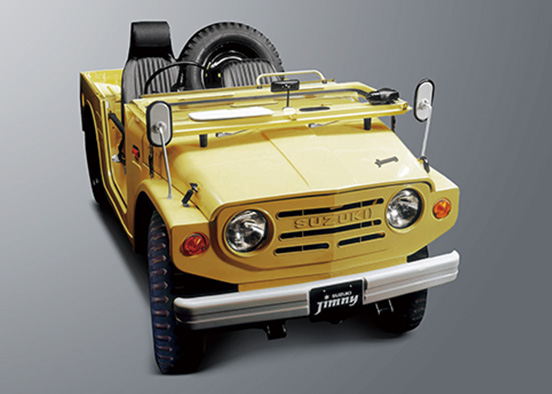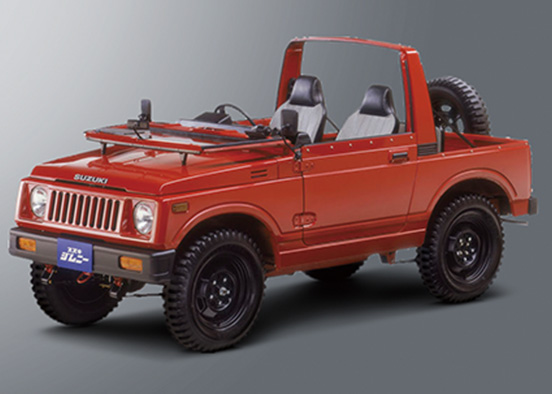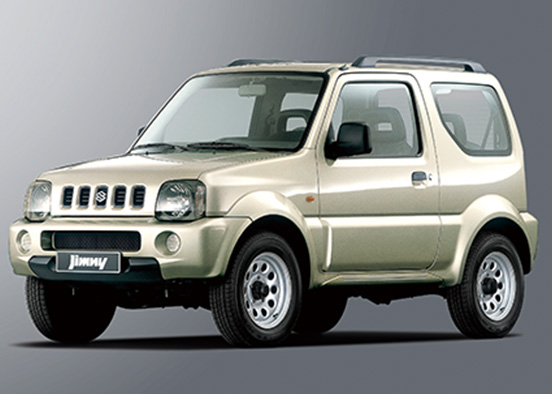Suzuki Jimny
Общие данные
| Годы пр-ва: | 1968—настоящее время |
На рынке
| Похожие модели: | Suzuki Vitara |
Впервые название Jimny введено в 1970 году Suzuki для обозначения компактных внедорожников, которые первоначально выпускались под маркой LJ (Light Jeep). Название Джимни составлено из двух слов — «джип» и «мини».
Базовой моделью для Судзуки послужила разработка компании Hope Star — модель ON 360 образца 1967 года с двухтактным двигателем 21л.с. от Мицубиси и колёсной формулой 4х4. Производственные права на него были приобретены в конце 1968 года и в в апреле 1970 года с конвейера сошёл первый полноприводный автомобиль от Судзуки, серьёзно доработанный и изменённый, LJ10 Jimny или Brute IV.
Содержание
- 1 1. Suzuki Jimny LJ10, LJ20, LJ50 (SJ10), LJ80 (SJ20) 1970-1981гг
- 2 2. Suzuki Jimny SJ30, SJ40, JA51, JA71, JA11, JB31, JA12/22, JB32 1981-1998гг
- 3 3. Suzuki Jimny JB33, JB23, JB43, JB53 1998 г. — по н.вр.)
- 4
1. Suzuki Jimny LJ10, LJ20, LJ50 (SJ10), LJ80 (SJ20) 1970-1981гг
1. Поколения ( Suzuki Jimny LJ10, LJ20, LJ50 (SJ10), LJ80 (SJ20))
Общие данные
Первое поколение Jimny
- LJ10, 1970-72. 359 см.куб, воздушное охлаждение, 2-х тактный I2 FB двигатель.
1.1.1 25л.с, 3 места. 1970.04-71.01
1.1.2 27л.с. 1971.01-72.05
- LJ20, 1972-76. 359 см.куб, водяное охлаждение, 2-х тактный I2 L50 двигатель.
1.2.1 28л.с, горизонтальные полосы в решетке. Версия седана LJ20V добавлена. 1972.05-73.11.
1.2.2 Оранжевые сигналы поворота, передние габаритные фонари и поворотники разделены. 4-местный с запасным колесом, установленным на задней двери (LJ20F) добавлен. 1973.11-75.12.
1.2.3 Регламентирование норм выбросов понижает мощность до 26л.с. 1975.12-76.04.
- SJ10, также известный как Jimny55 или LJ50. 1975-81. 539 см.куб 2-х тактный I3 LJ50 двигатель.
1.3.1 26л.с, 33 в некоторых экспортных рынках. Экспорт только до 76.06. Улучшенный кузов, все модели теперь 4-х местные. 1975.09-77.06.
1.3.2 Новый, более высокий капот с вентпрорезями на переднем крае. Более усиленный задний мост, отличительные, расширенные арки из-за задней и передней колеи, большей на 100 мм. Бензобак увеличился с 26 до 40 л. 1977.06-78.11.
1.3.3 Новая решетка с ниже установленными фарами. Металлические двери, доступные с 1979года. 1978.11-81.05.
- SJ20, также известный как Jimny8 или LJ80. 1977-83. 797 см.куб SOHC I4 F8A двигатель.
1.4.1 «Большая» модель двигателя, главным образом для экспортных рынков. В продаже в Японии с 77.09. Усовершенствования шасси SJ20’s были также применены к SJ10. 1977.06-78.11.
1.4.2 Новые решетки с ниже установленными фарами. Металлические двери, доступные с 1979, так же как и более длинная версия (LJ81) — пикап. 1978.11-82.08
2. Suzuki Jimny SJ30, SJ40, JA51, JA71, JA11, JB31, JA12/22, JB32 1981-1998гг
2. Поколения (Suzuki Jimny SJ30, SJ40, JA51, JA71, JA11, JB31, JA12/22, JB32)
Общие данные
Характеристики
Массово-габаритные
Второе поколение Jimny
- SJ30, также известный как Jimny 550. 1981-87. 539 см.куб 2-х тактный I3 LJ50 двигатель.
2.1.1 Весь новый, более современный проект. Двигатель двухтактный сохранен, но с мощностью, увеличенной до 28л.с. 4MT. 1981.05-83.07.
2.1.2 Введено транзисторное зажигание. Версия с мягкой дверью прекращена, улучшенная Фургон получает передние дисковые тормоза. 1983.07-84.06.
2.1.3 Новая, вся пластмассовая приборная панель. 1984.06-86.01.
2.1.4 SJ30 получает интерьер от JA51/71. 1986.01-87.04.
2.1.5 Введены ремни безопасности ELR, модельный ряд сокращён до полно-металлического кузова и улучшенной фургон. 1987.04-87.11.
- SJ40, также известный как Jimny 1000 или SJ410. 1981-98. 970 см.куб 4-х тактный I4 F10A двигатель.
2.2.1 Введенный для экспортных рынков с 1982, в продаже в Японии от 82.08. 45 л.с для экспорта, 52 л.с на внутреннем рынке. Шире и с большими колесами чем Jimny 550, с доступной моделью пикапа LWB. 1981.09-84.06 .
2.2.2 Улучшенный интерьер от JA51. Производство продолжается в других странах до 1998. 1984.06-85.
- JA51, также известный как Jimny 1300, SJ413 и Самурай. 1984-93. 1 324 см.куб. 4-х тактный I4 G13A двигатель,
впоследствии 1298 см.куб G13ВА. 2.3.1 Больший двигатель, новая пластмассовая решетка и улучшенный интерьер. 63-70 л.с., в зависимости от рынка. 5MT. 1984.08-88. Введённ в США в 1985 как Самурай. Остеклённая версия высокой крыши была добавлена в 85.12.
2.3.2 Постепенно вводились версии с двигателем со впрыском топлива. Улучшенная приборная панель. Название Самурай полностью заменяет SJ413, хотя автомобиль продавался под бесчисленными другими названиями. 1988-90.02.
2.3.3 Новые бампера, решетка. Пересмотренная подвеска, чтобы улучшить «шоссейное поведение». 1990.02-93.05 (по другим данным- до 94.12).
- JA71, 1986-90. 543 см.куб с турбинным и впрыском топлива двигателем F5A.
2.4.1 42л.с., Турбо, четырехтактный двигатель, 5MT. Модернизированный интерьер. 1986.01-87.03.
2.4.2 Новые решетки с интегрированными противотуманными фарами. «Панорамная» версия с высокой крышей добавлена, также как и промежуточный теплообменник. Мощность — до 52 л.с. Фургон минимальной комплектации доступен без интеркулера, с 38 л.с турбо двигателями. 1987.11-90.02
- JA11, 1990-95. 657 см.куб с впрыском топлива и интеркулером двигатель F6A с турбиной.
2.5.1 Больший двигатель и больших передние бампера отражают новые Kei Jidosha стандарты. Противотуманные фары стали выше, перед решеткой. Все модели получают новые 55 л.с двигатели. Подвеска изменена, чтобы улучшить управляемость и стабильность. 1990.02-91.06.Новая, цветная решетка. Мощность увеличилась до 58л.с, измененное устройство вентилятора радиатора. 1991.06-92.07.
2.5.3 Опционно доступны усилитель руля и АТ. 1992.07-94.04.
2.5.4 Улучшилось оборудования Безопасности. Дешевая версия ХА Фургон прекращена. 1994.04-95.02.
2.5.5 Двигатель, модернизированный до 64л.с от Alto Works. 1995.02-95.11.
- JB31, также известный как Jimny 1300 Сьерра (Сиерра), Самурай. 1993-95. 1 298 см.куб с впрыском топлива двигатель G13BA.
2.6.1 70 hp (JDM, отличается по экспортным рынкам), большие расширители арок, чтобы соответствовать 205/70 R15 шинам. Больше upmarket (ориентированный на внешний рынок), чем JA51, более удобный интерьер. 3AT доступна с 93.11. 1993.05-95.11.
- JA12/22, 1995-98. 657/658 см.куб с впрыском топлива и интеркулером двигатель F6A/K6A с турбиной.
2.7.1 Новая, пружинная подвеска шасси, более аэродинамический перед и новые бампера. 64 л.с двигателя сохранили, кроме топовых моделей, которые получили двигатель K6A с четырьмя клапанами DOHC — официально также с 64л.с. Версии K6A получили в стандарте электроусилитель руля, более дешёвые модели оснащались гидравлическим. 1995.11-97.05.
2.7.Вакуумное включение хабов добавлено. 1997.05-98.09.
- JB32, также известный как Jimny 1300 Сьерра (Сиерра), Самурай. 1995-98. 1 298 см.куб с впрыском топлива G13BB или G13BA (экспортный) двигатель.
2.8.1 85 л.с (JDM, 70 л.с в большинстве экспортных рынков). Модификации шасси согласно JA12/22, но длиннее и шире, чем 660 см.куб версии. Колея также шире, на 110 мм. 1995. 11-98.01.
3. Suzuki Jimny JB33, JB23, JB43, JB53 1998 г. — по н.вр.)
3. Поколения (Suzuki Jimny JB33, JB23, JB43, JB53 )
Общие данные
Третье поколение Jimny
- JB33, также известный как Широкий Джимни (Jimny Wide). 1998—2005. 1298 см.куб 16 клапанов SOHC G13BB двигатель.
3.1.1 Третье поколение с большим двигателем было представлено сначала. 5MT или 4AT. 1998.01-98.06.
3.1.2 Изменения в подвеске, чтобы улучшить стабильность и управляемость. Производство продолжается в Santana(Испания) для европейского рынка, также в кузове полукабриолет (Canvas Top) с 1999. 1998.06-2005.
- JB23. 658 см.куб с впрыском топлива и интеркулером двигатель K6A с турбиной.
3.2.1 Более закруглённый кузов, все еще на раме лестничного типа. Базовые модели XA, XL и топовая XC, все доступны с 5MT или 4AT. 1998.10-99.10.
3.2.2 Улучшенна безопасность и оборудование эмиссии. Перемещенный катализатор, ABS и воздушные подушки теперь стандарт. 1999.10-00.04.
3.2.3 Измененные ABS. 2000.09 2WD Jimny L введен. 2000.04-02.01.
3.2. Решётка радиатора теперь раздельна с капотом. Улучшен двигатель. 2002.01-04.10.
3.2.5 Измененные приборные панели, включение режимов движения. Увеличение отношения передач. 2004.10-05.10.
3.2.6 Внешние зеркала изменились, введён ручной корректор регулирования фар. 2005.10-08.06.
3.2.7 Изменения к головке цилиндра улучшают вращающий момент на низких оборотах. 2008.06 по наст. время.
- JB43, также известный как Jimny Wide или Jimny Sierra. С 2000года. 1 328 см.куб VVT 16 клапанов DOHC M13A двигатель.
3.3.1 Новый высоко- технический двигатель, 88 л.с, заменяет JB33 в Японии. 2000.01-2000.04. 3.3. Модифицированные двигатели. 2000.04-2002.01.
3.3.3 Названия, измененные назад на Jimny Сьерра (Сиерра). 2002.01-2004.10.
3.3.4 Изменение приборной панели, как и выбора режима движения, согласно JB23. 2004.10-05.11.
3.3.5 Внешние зеркала изменились, ручной корректор фар добавлен. 2005.11-2008.06.
3.3. Изменения кондиционера и включения хабов. С 2008.06 по наст. время.
- JB53, с 2003года. 1 461 куб. см. дизельный двигатель с турбонаддувом K9K Рено.
3.4.1 Выпускается Santana (Испания), чтобы удовлетворить потребность европейского рынка в дизелях. 65 л. с., K9K 700. 2003.12-2005.10.
3.4.2 86 л.с. K9K 266 двигатель. 2005.10 — по наст. время.
Общие данные
| G13BB | |
|---|---|
| Марка: | G13BB |
| Тип: | бензин |
| Объём: | 1,3 л см3 |
| Максимальная мощность: | 80-86 л.с. кВт |
| 1,5 TD | |
|---|---|
| Марка: | 1,5 TD |
| Тип: | дизель |
| Объём: | 1,5 л см3 |
| Максимальная мощность: | 65-86 л.с. кВт |
Характеристики
Массово-габаритные
| Длина: | 3645−3805 мм (JB32) 3295 мм (JB23) |
| Ширина: | 1600−1645 мм (JB32) 1395 мм (JB23) |
| Высота: | 1670−1705 мм (JB32) 1700 мм (JB23) |
Suzuki Jimny JB32
| Suzuki Jimny на Викискладе? |
-
-
#31
Ответ: Re: что означает слово ДЖИМНИ??
Окунь — это «Сузуки»…
:thumbsup:
Ваша правда.
Тем более, что в этом топике об этом уже говорилось – просмотрелРыдаю!
Добавлено через 1 минуту
Всёравно от воды далеко не ушли… «Мы все из неё вышли и однажды должны туда вернуться!»
На учет Джима поставил?
-
-
#32
Ответ: Re: что означает слово ДЖИМНИ??
Джимка мой с номерами уже вторые сутки! Пожелание сбылось,- выпил от души, но пока с женой, а друганы, которые мой кредит гарантировали, ещё пока, кто- в Питере гостит, а кто- в Кеми. Одиноко мне…Елки! А насчёт окуня….Точно! Нихрена не боится, выживает в любых условиях и чешуя(окраска) хрен сдерёшь! Не рыдай! Это- достойная рыбка!
-
-
#33
Ответ: Re: что означает слово ДЖИМНИ??
Джимка мой с номерами уже вторые сутки! Пожелание сбылось,- выпил от души, но пока с женой, а друганы, которые мой кредит гарантировали, ещё пока, кто- в Питере гостит, а кто- в Кеми. Одиноко мне…Елки! А насчёт окуня….Точно! Нихрена не боится, выживает в любых условиях и чешуя(окраска) хрен сдерёшь! Не рыдай! Это- достойная рыбка!
Ну не переживай, – я щазз тоже вмажу за здоровье твоего Джимки
-
-
#34
Ответ: Re: что означает слово ДЖИМНИ??
Ну не переживай, – я щазз тоже вмажу за здоровье твоего Джимки
![Wink ;) ;)]()
Значит, мы вмазали вместе? Эх, широка Страна моя родная!… Спасибо!
-
-
#35
Ответ: Re: что означает слово ДЖИМНИ??
Не знаю совпадение или нет, но в диснеевском мультфильме «Пинокио» 1940 года сверчка зовут Джимини
Glo
Jimny-модератор
-
-
#36
Ответ: Re: что означает слово ДЖИМНИ??
Не знаю совпадение или нет, но в диснеевском мультфильме «Пинокио» 1940 года сверчка зовут Джимини
![Smile :) :)]()
ДжимИни не есть ДжиМНи
-
-
#37
Ответ: Re: что означает слово ДЖИМНИ??
Учитывая отличия японского языка от всех остальных, а так же маниакальную любовь японцев к экзотике и мультипликации далеко не факт
А в целом пофик, но супруга моя которая эксплуатирует Джимника 80% времени когда это узнала захотела такую наклейку на чехол запаски
Вот теперь думаю где взять…
Glo
Jimny-модератор
-
-
#38
Ответ: Re: что означает слово ДЖИМНИ??
…супруга моя которая эксплуатирует Джимника 80% времени когда это узнала захотела такую наклейку на чехол запаски
![Smile :) :)]()
Вот теперь думаю где взять…
Найти изображение, перевести в вектора и заказать Или искать знакомого дизайнера, который сможет перевести. А плоттерную резку винила сделает практически любая фирма оперативной полиграфии. С многоцветной печатью на виниле — уже будет сложнее. Но вроде все, кто занимается изготовлением наклеек на авто, берутся делать по эскизам заказчика. Цена вопроса только меняется.
-
-
#39
Ответ: Re: что означает слово ДЖИМНИ??
A вот ещё наблюдение- набор JIMNY на QWERTY клавиатуре напоминает какой-то знак, может в Японии он что-то значит, спеца бы какого спросить… Версия трансформации из LJ (лёгкий джип) в JIMNY (джип-мини) бесспорной не выглядит.
-
-
#40
Ответ: Re: что означает слово ДЖИМНИ??
A вот ещё наблюдение- набор JIMNY на QWERTY клавиатуре напоминает какой-то знак, может в Японии он что-то значит, спеца бы какого спросить…
А что, это идея
Сидел-сидел тоскливый япошка и думал как же назвать эту новую чудо-машинку и в сердцах хрясь кулаком по клавиатуре. А тут такая красота получилась — JIMNY. Во, думает япошка, класс! Да еще и эти круглоглазые с форума suzuki-club (любил он этот форум тоже иногда почитывать) пусть голову поломают как это у меня так вышло… :hilarious:
-
-
#43
Ответ: что означает слово ДЖИМНИ??
スズキ — морской окунь, именно так пишется название марки — Сузуки, но перевод здень неуместен т.к. это фамилия основания!
Jimny — название модели — пишется всегда латинскими буквами -видимо имеет не японское происхождение! такого слова в япоском языке точно нет. К сожалению на официальном сайте компании ничего не говорится о происхождении данного названия. Остается только гадать
-
-
#45
Ответ: что означает слово ДЖИМНИ??
эээээ нет если посмотреть на официальном сайте сузуков, иероглифы совсем другие..как я написал
-
-
#46
Ответ: что означает слово ДЖИМНИ??
эээээ нет если посмотреть на официальном сайте сузуков, иероглифы совсем другие..как я написал
![Wink ;) ;)]()
Страницей раньше также: » 鈴木
ジムニ
Так пишется по-японски Suzuki Jimny (читается Jimuni).
Suzuki — это фамилия такая очень распространенная, как и Honda.
По kanji — иероглифам это значит «дерево-колокольчик», а по другой системе (в словаре) переводится как «окунь».»
Надо бы написать официалам- пусть внесут ясность.
-
-
#47
Ответ: Re: что означает слово ДЖИМНИ??
Japan
Incredible
Machine
Necessary
Yourself
это как Валли что ли?
-
-
#48
Ответ: что означает слово ДЖИМНИ??
от mini jeep не катит..эт только в россии jeep — слово обозначающее внедорожники..а в забугорье это марка машины, так что вряд ли япохи стали бы называть mini jeep почему тогда не мини додж или не мини форд)))
-
-
#49
Ответ: что означает слово ДЖИМНИ??
от mini jeep не катит..эт только в россии jeep — слово обозначающее внедорожники..а в забугорье это марка машины, так что вряд ли япохи стали бы называть mini jeep почему тогда не мини додж или не мини форд
)))
Ну можно поспорить — http://auto.mail.ru/article.html?id=32455
Что касается Джимни, есть варианты, но надо лезть в историю выпуска автомобиля.
Существуют разные версии версии, например: «1970 год,Suzuki Motor Co., Ltd. отмечает корпоративный юбилей: прошло ровно 50 лет с того момента, когда Мичио Сузуки учредил в Хамамцу акционерное общество Suzuki Jidosha Kogyo. Весной состоялся рыночный дебют первого автомобиля Suzuki с приводом «4×4» — трехместного внедорожника Jimny серии LJ. Первые выпуски этих мелкогабаритных японских «виллисов» с открытыми кабинами и брезентовыми бортами оснащались двухцилиндровым моторами с воздушным охлаждением. При мизерном объеме всего 359 «кубиков» экономичный двигатель Suzuki Jimny развивал вполне приемлемую для сверхлегкого вездехода мощность 25 л.с. «
По сравнению со «взрослыми внедорожниками» это действительно мини.
-
-
#50
Ответ: что означает слово ДЖИМНИ??
スズキ — морской окунь, именно так пишется название марки — Сузуки, но перевод здень неуместен т.к. это фамилия основания!
Jimny — название модели — пишется всегда латинскими буквами -видимо имеет не японское происхождение! такого слова в япоском языке точно нет. К сожалению на официальном сайте компании ничего не говорится о происхождении данного названия. Остается только гадать![Smile :) :)]()
Jimny — это официальное сокращение от jeep mini — ИМЕННО ТАК указано в японском каталоге для внутреяпонского рынка, текст был на японском. каталог за 99-2000 год, называется japanese motor vehicle catalog
Добавлено через 5 минут
от mini jeep не катит..эт только в россии jeep — слово обозначающее внедорожники..а в забугорье это марка машины, так что вряд ли япохи стали бы называть mini jeep почему тогда не мини додж или не мини форд
)))
как раз таки катит! первые джимы у которых еще названия не было, а просто цифровое обозначение смахивали на виллис военный, а джим еще и маленький.
Хз чо там и как, но в японском каталоге на японском иерголифами так и написано про джип+ мини. Если бы был под рукой — сделал бы скан страницы каталога, но я в мск, а каталог во Владивостоке.
я говорю то, что знаю. ТО что было там на японском написано и я типа мог не понять — сомневаюсь, особенно после 5 лет учебы на востфаке и имея диплом по языку
Добавлено через 2 минуты
от mini jeep не катит..эт только в россии jeep — слово обозначающее внедорожники..а в забугорье это марка машины, так что вряд ли япохи стали бы называть mini jeep почему тогда не мини додж или не мини форд
)))
ну как сказать….в японии сами японцы, которые увликаются оффроудом очень часто говрят и называют крузаки, сафари, паджерики и тп именно жипами, так, вообще, для сведения
-
-
#51
Ответ: что означает слово ДЖИМНИ??
Я тоже при покупке интересовался значением слова «джимни», моя версия джимни — это вагонетка (уголь возит которая).
14th
Сузуковод со стажем
-
-
#52
Ответ: что означает слово ДЖИМНИ??
от mini jeep не катит..эт только в россии jeep — слово обозначающее внедорожники..а в забугорье это марка машины, так что вряд ли япохи стали бы называть mini jeep почему тогда не мини додж или не мини форд
)))
Пендосы, так же как и все остальные раздолбаи, называют джипом все подряд, внешне напоминающее внедорожник.
К сожалению.
-
-
#53
Ответ: что означает слово ДЖИМНИ??
.в японии сами японцы, которые увликаются оффроудом очень часто говрят и называют крузаки, сафари, паджерики и тп именно жипами, так, вообще, для сведения
И финики тоже… Причем вовсе не увлекающиеся оффроудом. Лучше покажите нацию, которая НЕ называет внедорожники джипами
-
-
#54
Ответ: что означает слово ДЖИМНИ??
И финики тоже… Причем вовсе не увлекающиеся оффроудом. Лучше покажите нацию, которая НЕ называет внедорожники джипами
![Wink ;) ;)]()
Щас таки пгидет хитрый EDI, и все вам обгяснит.
(шутка юмора)
-
-
#56
Ответ: что означает слово ДЖИМНИ??
Н-да. Можно запутаться, スズキ・ジムニー — это с сайта о Джимни, япона-мама панимашь-ли, что тут скажешь, перевести бы…
(
http://ja.wikipedia.org/wiki/スズキ・ジムニー
)) переводчик Гугл переводит это как Suzuki Jimny
))))))))
-
-
#57
Ответ: что означает слово ДЖИМНИ??
)) переводчик Гугл переводит это как Suzuki Jimny
))))))))
В том-то и дело — круг замыкается. Джимни не переводится, просто заимствованное слово. В лоб не проходит, японоведа надо бы…
-
-
#58
Ответ: что означает слово ДЖИМНИ??
В том-то и дело — круг замыкается. Джимни не переводится, просто заимствованное слово. В лоб не проходит, японоведа надо бы…
![Wink ;) ;)]()
*****
車名 [編集]
車名の由来はジープ(Jeep)型のミニという意味を込め、「Jeep」と「Mini」をかけあわせ命名されたものであり[1]、メーカーの公式発表でも「発音のしやすさ、覚えやすさなどから作った造語である」とされている。北米発の愛称は「Suzy(スージー)」。
軽自動車として同一車種名での歴史の長さを誇る車種のひとつである。誕生から長い間、法定費用の面で有利な軽貨物となる4ナンバー規格(商用車)で販売されており、5ナンバーの軽乗用仕様の登場は1995年からと、比較的新しい。貨物仕様は1998年に廃止された。
****
Ребята!!! вы читать умеете или как??? Я вам уже писал, что я находил в японском каталоге данные об наименовании джими, так же писал, что я японовед. Конкретно для тех кто не верит — в японской википедии нопейсано
***
Название
Автомобиль получил свое название от Jeep (Джип), означает, что мини, «Джип» и «Мини» и название было сделано, даже производителем официальног объявлено «.
…….
***
:whistling::whistling::whistling::whistling:
-
-
#59
Ответ: что означает слово ДЖИМНИ??
*****
車名 [編集]
車名の由来はジープ(Jeep)型のミニという意味を込め、「Jeep」と「Mini」をかけあわせ命名されたものであり[1]、メーカーの公式発表でも「発音のしやすさ、覚えやすさなどから作った造語である」とされている。
Ребята!!! вы читать умеете или как??? Я вам уже писал, что я находил в японском каталоге данные об наименовании джими, так же писал, что я японовед. Конкретно для тех кто не верит — в японской википедии нопейсано
***
Название
Автомобиль получил свое название от Jeep (Джип), означает, что мини, «Джип» и «Мини» и название было сделано, даже производителем официальног объявлено «.
…….
***
Википедия не является источником официальной информации, перевод можно сделать и так:
Название автомобиля . Происхождение названия автомобиля Jeep (Джип) означает, что мини-типа, «Джип» и «Мини» и название было сделано Kakeawa [1], даже официальные производителя «произношением по Ясу Noshi это придумано слово из виду и простоте »
был.
Понять бы о чём речь- кто такой Kakeawa и что за произношение по Ясу Noshi. При всём своеобразии восточных языков предположить в названии автомобиля сочетание «LJ Jimny»- Light Jeep Jeep Mini (Лёгкий Джип Джип Мини) сложновато, тут масло масляное отдыхает. К тому же приводится и другое название- первоначальное наименование модели — Brute IV. Надо бы покопаться посерьёзней.
EDI
Эксперт-старожил
-
-
#60
Ответ: что означает слово ДЖИМНИ??
О сколько нам открытий чудных
Готовят просвещенья дух
И опыт, сын ошибок трудных,
И гений, парадоксов друг,
1970 г., Suzuki обнаружив, что мировые производители не производят небольших внедорожных автомобилей по доступной цене и с повышенной проходимостью. Был подготовлен автомобиль
Jimny LJ10
Suzuki Eljot
1970–1981
Lightweight Jimny (LJ) 4×4. Шасси были как у компактного автомобиля с максимальной длиной 3,2 м, а рабочий объем двигателя не более 360 см3. LJ был оснащен двухтактным двухцилиндровым двигателем с максимальной мощностью 24 л. с. Его легкость и бескомпромиссный полный привод сделали LJ 20 прекрасным первопроходцем.
Jimny 55
1975–1977
Потребовалось еще 7 лет, чтобы доработать концепт LJ так, чтобы он стал популярным по всему миру. В 1977 году Suzuki выпустила LJ 80 с четырехцилиндровым двигателем объемом 767 см3, мощностью 40 л. с. Успешные продажи были не единственным доказательством успеха Suzuki – LJ образовал новый класс автомобилей среди внедорожников.
Samurai
1981–1998
Suzuki Caribbean
Suzuki Katana
Suzuki Katana
Suzuki Potohar
Suzuki SJ410
Suzuki Samurai
Suzuki Santana
Suzuki Sierra
Chevrolet Samurai
Holden Drover
в 1982 году появился SJ 410 с литровым четырехцилиндровым двигателем мощностью 45 л. с., который в 1985 году увеличился по объему до 1,3 л и по мощности до 64 л. с. SJ был переименован и стал называться Samurai, завоевав значительную долю рынка. К 1988 году Suzuki становится ведущим производителем компактных автомобилей с постоянным полным приводом. Пришло время расширить линейку и создать новый автомобиль, чтобы предложить приверженцам бренда что-то новое в полюбившейся категории.
Jimny JA71
Jimny JA12W
Jimny JB23
1998- 2012
Suzuki Jimny Wide
Suzuki Jimny Sierra
Chevrolet Jimny
Mazda AZ-Offroad
рестайлинг 2012 года
материал взят из открытых источников Internet.
| Suzuki Jimny | |
|---|---|

2019 Suzuki Jimny |
|
| Overview | |
| Manufacturer | Suzuki |
| Production | April 1970 – present (2.85 million units sold by September 2018[1]) |
| Body and chassis | |
| Class | Off-road mini SUV (B) Kei car |
| Body style |
|
| Layout |
|
| Related |
|
The Suzuki Jimny (Japanese: スズキ・ジムニー, Suzuki Jimunī) is a series of four-wheel drive off-road mini SUVs, manufactured and marketed by Japanese automaker Suzuki since 1970.
Originally belonging to the kei class, Japan’s light automobile tax/legal class, the company continues to market a kei-compliant version for the Japanese and global markets as the Jimny, as well as versions that exceed kei-class limitations. Suzuki has marketed 2.85 million Jimnys in 194 countries through September 2018.[1]
History[edit]
The history of Suzuki four-wheel drive cars began in the latter half of the 1960s, when Suzuki bought a Steyr-Puch Haflinger to study with the intent of building a kei-class off-road vehicle.[2] A better opportunity presented itself in 1968, when Suzuki was able to buy bankrupt Japanese automaker Hope Motor Company, which had introduced a small off-road vehicle called the HopeStar ON360. The tiny Hope company had been unable to enter series production, and only about 45 were manufactured.[2] The first Suzuki-branded four-wheel drive, the LJ10 (Light Jeep 10), was introduced in 1970. The LJ10 had a 359-cc, air-cooled, two-stroke, in-line two-cylinder engine. The liquid-cooled LJ20 was introduced in 1972 with the cooling changed due to newly enacted emission regulations, and it gained 3 hp. In 1975, Suzuki complemented the LJ20 with the LJ50, which had a larger 539 cc, two-stroke, in-line three-cylinder engine and bigger differentials. This was originally targeted at the Australian market, but more exports soon followed.[3]
The Jimny8/LJ80 was an updated version of the LJ50 with an 800 cc, four-stroke, in-line four-cylinder engine, followed by the Jimny 1000/SJ410 and Jimny 1300/SJ413. An updated version of the SJ413 became known as the Samurai and was the first Suzuki officially marketed in the US. The series from SJ410 to SJ413 was known as the Sierra in Australia, and remained the Jimny in some markets.
The new Jimny was released in 1998, and now bears the same name in all markets. The 1998 release used the G13BB EFI engine, replaced by the M13AA EFI engine in 2001 and the M13AA variable valve timing engine in 2005, in conjunction with a minor interior redesign.
Common design characteristics[edit]
Overall construction[edit]
All four Jimny generations have separate frame and body («ladder frame chassis»). The body has no structural carrying role. It serves only as a cabin to protect the occupants from the elements, provide comfort, and protect them in the case of a crash.
Suspension[edit]
All four Jimny generations have dependent suspension (solid-beam axles) both at the front and rear axles. This used to be a common suspension design for all-terrain vehicles up to 1990s, but has become a rarity in vehicle design in the 21st century. Dependent suspension is particularly well suited for all-terrain duty, both from the durability and performance perspectives.
The first two Jimny generations used leaf-sprung suspension at all four wheels, with the third and fourth generations using coil-sprung suspension at all four wheels. Some late second-generation models had coil-sprung suspension, as well.
Steering[edit]
All four Jimny generations have recirculating ball steering mechanism, which is particularly well suited for all-terrain duty, but relatively imprecise on-road compared to modern rack-and-pinion steering construction.
Transmission[edit]
All four Jimny generations have manually user-selectable part-time four-wheel drive (4WD) transmission, where the default (on-road) transmission mode is two-wheel drive (rear-wheel drive). Rear-wheel drive can never be disengaged. The user, however, can (dis)engage the front-wheel drive (FWD) manually at any time under certain operating conditions. When FWD is also engaged, this provides 4WD.
Jimnys have no centre (interaxle) differential. This has a positive effect that at least two wheels, where each wheel is on a different axle, have to lose traction for the vehicle to lose traction when in 4WD transmission mode. However, the negative effect is that 4WD transmission mode must not be used on any surface not rather slippery, especially if having to steer. In other words, 4WD transmission mode should be used only on rather slippery surfaces, like snow, ice, mud, loose gravel, wet grass, and sand. Wet asphalt, wet concrete, and hard-packed gravel are not considered slippery enough.
All four Jimny generations have manually user-selectable dual-ratio (dual-range) gearing mechanism. The two ratios or ranges are called «high range» (for regular on-road driving and light to moderate all-terrain driving) and «low range» (for moderate to hard all-terrain driving and for all-terrain towing). The overall transmission gearing ratio is exactly halved when the vehicle is in low=range transmission mode. This has the effect of the vehicle moving about half as fast, but with double torque at the wheels in any transmission gear. For example, the fourth gear in low range behaves similar to the second gear in high range, and third gear in low range behaves similarly as «1.5th gear» in high range.
The transmission gearing range is selectable only when the vehicle is in 4WD transmission mode. Therefore, low range cannot be used for on-road towing.
The (dis)engagement of 4WD transmission mode and the switch from one gearing range to another is performed by a dedicated transfer case mechanical unit, which is separate from the regular gear box unit. All four Jimny generations have a transfer case with an attached selection lever protruding in the cabin between the main gear box lever and the handbrake lever. The lever allows the user to select 2WD-H, 4WD-H or 4WD-L transmission modes at will. The only exceptions are later production years of third-generation Jimnys (more info in a dedicated chapter), which do not have a selection lever, but instead have servo-actuated mechanism to perform the same actions when invoked by the push of certain buttons in the cabin.
Factory rear axle differential locker[edit]
LJ80, SJ410, and early SJ413 vehicles sold in Germany were fitted from the factory with a manually operated, mechanical rear axle differential locker. A cable connected the locker to a small, dedicated lever in the cabin near the hand brake lever. By operating the lever, the driver could manually fully (un)lock the rear axle differential.
The reason for inclusion of the differential locker was legislative in nature. LJ80s, SJ410s, and early SJ413s have a parking brake that brakes the gears in the transfer case instead of braking the individual rear wheels directly and simultaneously (as with most passenger vehicles). That design has several advantages, as well as an important disadvantage — because of the open rear differential, the hand brake has no effect when the transfer case is in two-wheel drive (rear-wheel drive) mode and when one of the rear wheels is raised in the air. Therefore, relying on the parking brake itself would be dangerous in some unusual situations (when parking on a severely undulated ground). German law required that this risk must not exist. Instead of redesigning the parking brake system for that market, Suzuki appeased the legal requirement by the inclusion of a rear differential locker. The idea was that German drivers, when parking, should lock both the hand brake lever and this additional differential lock lever.
Despite being formally intended as a parking brake assistance only, this rear axle differential locker is a fully fledged device. Therefore, it is perfectly usable and durable in all-terrain driving situations over undulated or very slippery ground.
Later SJ413s (and all Samurais) have a standard parking brake that works on both rear wheels directly. This design appeased the German legal requirement, so no differential locker has been factory fitted to SJ413s nor to any Samurai since.
A retrofit of a genuine rear differential locker to LJ80s, SJ410s and SJ413s which lack it, is possible by using the parts from a dismantled LJ80, SJ410, or early SJ413 which had that locker. Lockers from LJ80 are usable on another LJ80 only, while lockers should be interchangeable between SJ410 and SJ413 and vice versa. A retrofit from SJ41x onto a Samurai is not easily possible, because Samurai has wider track and axle than SJ41x.
HopeStar ON360[edit]
The vehicle was originally developed by the Hope Motor Company of Japan in 1967 and available as the HopeStar ON360 from April 1968. It used a Mitsubishi 359 cc (21.9 cu in) air-cooled, two-stroke ME24 engine, which produced 21 PS (15.4 kW; 20.7 bhp) at 5,500 rpm, and 32 N⋅m (23.6 ft⋅lb) of torque at 3,500 rpm.[4] Brakes were Daihatsu units, the rear axle was sourced from the Mitsubishi Colt 1000, and the wheels were sourced from the Mitsubishi Jeep. It was a very basic two-seater vehicle with no doors, but a sturdy 4WD system allowed it to go off-road. Top speed was 70 km/h (43 mph), 30 km/h (18.6 mph) in four-wheel drive mode. The tiny Hope company sold very few ON360s, only 15 in the domestic market and another 30 exported to Southeast Asia,[2] although 100 ME24 engines were purchased.[5][6] Hope proceeded to sell the design to Suzuki in 1968, after Mitsubishi declined to take over production.
First generation (1970)[edit]
| First generation (LJ10-SJ20) | |
|---|---|

Suzuki Jimny LJ10 |
|
| Overview | |
| Also called | Suzuki LJ50/LJ55/LJ80 Suzuki Eljot (Germany) Suzuki Stockman (Australia)[7] |
| Production | 1970–1981 |
| Body and chassis | |
| Body style | 2-door wagon 2-door convertible 2-door cab chassis[7] |
| Powertrain | |
| Engine |
|
| Transmission | 4-speed manual |
| Dimensions | |
| Wheelbase | 2,030 mm (79.9 in) |
| Length | 3,195 mm (125.8 in) |
| Width | 1,296 mm (51.0 in) |
| Height | 1,660 mm (65.4 in) |
| Chronology | |
| Predecessor | HopeStar ON360 |
The compact off-road capable Suzuki Jimny was Suzuki’s first global success, lending it name recognition and a foothold in markets worldwide. The Jimny slotted into a hitherto unfilled gap in the market.
LJ10[edit]
Suzuki’s first move on acquiring the rights to the ON360 was rebodying it and replacing the Mitsubishi engine with an air-cooled 359 cc (21.9 cu in) Suzuki «FB» two-cylinder, two-stroke, which produced 25 PS (18 kW; 25 bhp). Since the new unit remained smaller than 360 cc, and Suzuki placed the spare tire inside the truck (making it a three-seater) to keep it under 3 m in overall length, it was classified as a kei car, conferring certain tax privileges and other benefits. When it was introduced in April 1970, it was the first four-wheel drive kei car to enter series production. The LJ10 Jimnys had 16-inch wheels, weighed 590 kg (1,301 lb), and had a top speed of 75 km/h (47 mph). The engine was soon uprated to 27 PS (20 kW; 27 bhp), but the claimed top speed remained unchanged.[8]
The original Jimny was an unexpected hit, with nearly 5,000 units selling in its home market in the first year, immediately outselling the market leader at the time, the Mitsubishi Jeep. Over 6,000 were sold in 1971.[2] Production was initially subcontracted and was carried out mainly by hand, but Suzuki soon realized that the Jimny needed to have a dedicated assembly line to allow production to be ramped up.[2]
LJ20[edit]
The LJ was updated in May 1972 and renamed the LJ20. The grille bars were changed from horizontal to vertical for the LJ20. The engine was replaced with an updated, water-cooled unit (the L50), and its 28 PS (21 kW; 28 bhp) enabled the LJ to reach 80 km/h (50 mph).[9] With production brought in house, Suzuki could now build 2,000 cars per month.[2]
Suzuki Jimny LJ20 (1973), note spare tire placement
A special version with the spare tire mounted behind the passenger seat allowed for two small rear seats, facing each other. The introduction of left-hand drive signaled Suzuki’s worldwide ambitions for the truck. The Hard Top (Van) was also introduced when the LJ20 arrived, equipped with smaller, 15 in wheels.[8] Suzuki did not export them to America; a US company called International Equipment Co. imported them. Export Jimnys had the spare tire mounted on the outside, as kei regulations on length did not apply.
Towards the end of LJ20 production, a cleaner 26 PS (19 kW; 26 bhp) engine was introduced, a result of ever more stringent emissions regulations. Top speed was reported as 93 km/h (58 mph), payload was 250 kg or 550 lb (200 kg or 440 lb for the Van version).[10]
SJ10[edit]
The LJ50 engine was first introduced in September 1975 for export only, with 33 PS (24 kW; 33 bhp). For the home market, it first appeared in June 1976 as the Jimny 55 and reflected the changing kei-car rules and stricter emissions standards. The 539 cc (32.9 cu in) three-cylinder engine remained a two-stroke; while power was reduced to 26 PS (19 kW; 26 bhp), more low-end torque was on offer. The 635 kg (1,400 lb) vehicle could now hit 60 mph (97 km/h), and the spare tire was relocated outside the rear door, allowing for a fourth seat. The SJ10 Jimny originally used the «LJ50» name in most export markets; this was changed to LJ55 with the introduction of the LJ80 to align the names.
1979 Suzuki Jimny SJ20 hardtop
In Australia, the LJ50S and LJ50V (van) were available as a soft-top with soft doors and rear-mounted spare wheel or hardtop with full metal doors and external spare wheel through distributor M.W.-Suzuki (Melbourne) with 33 hp (25 kW) and 5.85 kgf⋅m (57.4 N⋅m; 42.3 lbf⋅ft) of torque. In May 1976, the low-production LJ51P long-wheelbase pickup became available for some export markets. The home-market Jimny 550 received a facelift in 1977, introducing rear wheel-arch metal flares and a bigger bonnet or hood with cooling slots above the radiator, while the export LJ50s were instead replaced by the LJ80 (same external modifications, but with the new four-stroke, four-cylinder, 797-cc engine fitted).
SJ20[edit]
The final iteration of the original Jimny design was the 1977 Jimny 8, called LJ80 in certain export markets. It was originally intended to be marketed as the Eljot («Elliott») in Germany, but copyright issues with Disney’s Pete’s Dragon movie made this impossible. While the SJ10 remained in production for the domestic kei category, the new 770 kg (1,698 lb) SJ20 boasted a 797 cc (49 cu in) four-stroke SOHC four-cylinder F8A engine capable of around 31 kW (42 hp). The additional power and torque of this engine allowed the differential and gearing to be raised for better cruising and offroad performance, and the track was widened by 100 mm (3.9 in).[11] The LJ80V was also assembled in Indonesia, by P.T. Indo Mobil Utama in Jakarta.
The interior was also improved, with new seats and steering wheel. Metal doors became available for the first time in 1979, and a pickup truck model (LJ81) was available by April of that year, as well. The pickup, called «Stockman» in Australia, had a 2,200 mm (86.6 in) wheelbase (up by 270 mm (10.6 in)) and was 3,620 mm (142.5 in) long, compared to the 3,185 mm (125.4 in) LJ80. The Jimny 8/LJ80 was retired in late 1981 with the introduction of the second-generation Jimny.
Second generation (1981)[edit]
| Second generation (SJ30/SJ40/JA/JB) | |
|---|---|
 |
|
| Overview | |
| Also called | Chevrolet Samurai Holden Drover Maruti Gypsy Santana Samurai Suzuki Caribian Suzuki Katana Suzuki Potohar (Pakistan) Suzuki SJ410/413 Suzuki Samurai Suzuki Santana Suzuki Sierra Suzuki Fox (Iceland) |
| Production | 1981–1998 1981–2005 (Indonesia) 1985–2018 (India) 1986–2004 (Spain) |
| Assembly | Iwata, Japan Karachi, Pakistan Gurgaon, India Bekasi, Indonesia Bangkok, Thailand Nairobi, Kenya Bogotá, Colombia (GM Colombia) Linares, Spain (Santana Motor) |
| Body and chassis | |
| Body style | 2-door wagon 2-door van 2-door convertible 2-door pickup[12] 2-door cab chassis[13] 3-door wagon[14] 5-door wagon[14] |
| Layout |
|
| Powertrain | |
| Engine |
|
| Transmission | 4/5-speed manual |
| Dimensions | |
| Wheelbase | 2,030 mm (79.9 in) 2,375 mm (93.5 in) (LWB) |
| Length | 3,195–4,010 mm (125.8–157.9 in) |
| Width | 1,395–1,535 mm (54.9–60.4 in) |
| Height | 1,670–1,840 mm (65.7–72.4 in) |
| Chronology | |
| Successor | Suzuki Sidekick (Canada) Suzuki X-90 (United States) |
The Suzuki SJ30 began production in May 1981. In Japan, it was sold as the Suzuki Jimny and was a kei car, produced with both 550 cc and 660 cc 3-cylinder engines. The SJ-Series received a bigger engine and was lengthened and widened for export purposes, where it was sold with a multitude of names: Suzuki SJ410/413, Suzuki Samurai, Suzuki Sierra, Suzuki Potohar (Pakistan), Suzuki Caribian (Thailand), Suzuki Katana (Indonesia), Chevrolet Samurai, Holden Drover (Australia) and Maruti Gypsy (India [15]).
SJ30[edit]
The SJ30 Jimny 550 was mainly for Japanese domestic market consumption where it suited the Kei car category. Still powered by the LJ50 engine also used in its predecessor, the Jimny 550 was by a sizable margin the last two-stroke car engine built in Japan. Production ended with the withdrawal of type approval in November 1987 in favor of its F5A-engined brother, the JA71. The two-stroke had been favored by Japanese off-roaders (and by Suzuki) due to its light weight and superior low-speed torque.[16]
SJ40[edit]
Suzuki SJ410 (rear view)
Holden Drover cab chassis (QB, Australia)
The SJ40 Jimny 1000 was introduced for 1982 to replace the LJ80 range. The Jimny 1000, sold as the Suzuki SJ410 in most export markets, used the F10A — a larger 1-litre version of the LJ’s 0.8-litre four-cylinder engine. This engine produced 45 PS (33 kW; 44 hp) and it had a top speed of 68 mph (109 km/h). The Japanese market models claimed 52 PS (38 kW; 51 hp) at 5,000 rpm.[17] So that owners of 550 cc Jimnys would not be able to retrofit the larger, wider wheels of the Jimny 1000 to their cars, the Japanese ministry of transportation dictated that Suzuki fit wheels with a different bolt pattern.[citation needed]
A four-speed manual transmission was standard, as were non-power assisted drum brakes front and rear. The SJ410 came as a half-door convertible, long-wheelbase pickup truck, two-door hardtop (called «Van» in Japan), raised-roof hardtop, and no-glass hardtop (panel van). In Japan, the pickup truck was intended as a bare-bones work vehicle and did not receive fender extensions, and had diagonal tires on black-painted steel wheels rather than the sportier wheels fitted to the regular Jimny. Maximum payload is 350 kg (770 lb).[17] In the autumn of 1983 a covered long-wheelbase version was added for export markets.
The SJ410 was also produced in Spain by Santana Motor in their Linares, Jaén factory as of March 1985 and was sold as a domestic vehicle in Europe due to its over 60% native parts content, thereby evading limits on imports of Japanese-built automobiles.[18] It was built only on the short wheelbase, as a two-door convertible and commercial, or with the three door wagon or van bodywork. Some later models of the SJ410 would switch to disk brakes in the front depending on the factory they were made at. In March 1990, Santana-built versions received the same chassis developments which turned the SJ413 into the Samurai; this version was sold as Samurai 1.0 where it was offered («Samurai Mil» in Spain).[19] Cooper Motor Corporation (CMC) of Nairobi, Kenya, also assembled the SJ410 in the mid-eighties.[20]
Indonesian production[edit]
The SJ410 was also assembled in Indonesia by Suzuki Indomobil Motor since late 1982 until 2006, where it was marketed with different names. The original version was marketed as Suzuki Super Jimny, continuing from the previous LJ Suzuki Jimny. The canvas soft-top model was marketed in fairly small numbers from 1983 until late 1985 as Jimny Sierra.[21] In the late 1980s, responding to the introduction of higher taxes for vehicles with four-wheel-drive, Suzuki introduced a 4×2 version as the Suzuki Katana in September 1989.[21] The earlier model built until 1984 were low-roof, metal-bodied wagons. A higher-roofed model arrived in 1984 and continued to be built until about 1988, while the Katana has an even higher roof than the previous versions. Later, there were also 1.3-liter models sold in small numbers as the Jimny Samurai.[21]
As of September 1989, it received updated square headlights. The rear-wheel drive Katana was also used as a basis for an Indonesian-built, 1930s’ style kit-car called the Marvia Classic.[22] The earlier Katana is only available with «Blitz» variant until a light facelift in late 1992 (round headlights) and mid 1993 (new grille design with round headlights and S logo). In the same year, the Blitz variant was replaced with the long-running GX series Katana. The Suzuki Katana GX was produced from 1993 to 2006, with updates only on body sticker design in 1995, 1997, 1999, 2000, 2002, and 2005. There was also a DX variant of Katana below the GX, marketed from 1993 to 2000. In 2005, Suzuki introduced the SJ413 Caribian spacecab pickup, which was imported from Thailand until 2007.[21] Production of the second generation Jimny (and Katana) in Indonesia ended in 2006.
Maruti Gypsy[edit]
The Indian built SJ-410 has only ever been available in a long-wheelbase version. The Gypsy remained in production for the Indian Subcontinent market until 2019. The version still produced in India by Maruti Suzuki was the Maruti Gypsy King, using the sixteen valve, 80 hp (60 kW) 1.3-liter G13 engine. The Gypsy King is still popular with the Indian armed forces and police units.
Farm Worker 4×4[edit]
In 2013, Suzuki New Zealand reintroduced the Suzuki SJ series into New Zealand badged as the Suzuki Farm Worker 4×4,[23] although the Maruti badge can clearly be seen in the centre of the radiator grille. The vehicle is actually the leaf-sprung Suzuki Maruti Gypsy King MG413W, powered by the G13BB 1.3-litre, 16 valve engine, producing 80 hp (60 kW) at 6,000 rpm and 103 N⋅m (76 lb⋅ft) of torque at 4,500 rpm, mated to a five-speed, all synchromesh gearbox and a high/low 2wd/4wd transfer box. The Farm Worker is available in four slightly differing styles, two having a rear window and fibreglass bulkhead, and two having canvas roofs with foldable front windscreens, all based on the long wheelbase version (the only version built by Maruti) and offering a maximum payload of 500 kg. As its name suggests the Farm Worker is intended for farm work only and is not able to be road registered due to the vehicle not meeting current crash protection regulations,[citation needed] although it does come with seat belts for the front two seats.
SJ413/Samurai[edit]
JA51 1300[edit]
In 1984, the SJ was revamped with the launch of the SJ413 (internal model code JA51). The SJ413 included a larger 1.3-liter four-cylinder engine, 5-speed manual transmission and power brakes (disc brakes on the front and drum brakes on the rear) all around. The body and interior were also redesigned, with the introduction of a roll bar, along with a new dashboard, seats, and grille. The SJ410 remained in production for various other markets with the old specifications. After the 1988 introduction of the Escudo, sales of the Jimny 1300 ended in Japan. The model returned to the Japanese market in May 1993, after a thorough update.
SJ413 had the same track width as SJ410. As those two car models were relatively susceptible to a rollover, Suzuki introduced a wider edition of SJ413 around 1988, with its track widened by 10 cm. Wider track gave the vehicle more stability. This wider edition received the nameplate «Samurai». The difference in width is the only major difference between SJ413 and Samurai, apart from some minor cosmetic changes in the interior and the exterior.
The Samurai was also produced in a long wheel base (LWB) edition for certain markets, but still with three doors. That LWB edition still had only two rear seats (if fitted at all) for two rear passengers, and the rear passenger leg room was the same as in the standard SWB edition. The extended vehicle length only affected the boot/trunk space behind the rear seats, which was significantly larger in the LWB edition.
North American market[edit]
The SJ-Series Samurai was introduced to the United States in 1985 for the 1986 model year. It had gone on sale earlier in Canada and Puerto Rico (as the Suzuki SJ410). It was priced at $6200 when introduced in the United States and 47,000 were sold in its first year. It had a 1.3-liter, 63 hp (47 kW; 64 PS), four-cylinder engine and was available as a convertible or a hardtop, and came equipped with rear seats until 1994. The Suzuki Samurai became intensely popular within the serious 4WD community for its good off-road performance and reliability compared to other 4WDs of the time, outselling the Jeep Wrangler by two to one in 1987.[24] This is due to the fact that while very compact and light, it is a real 4WD vehicle equipped with a transfer case, switchable 4WD and low range. Its lightness makes it a very nimble off-roader less prone to sinking in softer ground than heavier vehicles. It was also sold as the Chevrolet Samurai in Puerto Rico.
The 1988.5 model Samurai was re-tuned for better on-road use in the United States. This revision included softer suspension settings and a larger anti-roll bar to reduce body roll. A lower fifth gear (.865:1 vs the earlier .795:1) increased engine speed and power on the highway, and improved dashboard and seats made the Samurai more comfortable.
A new 1.3 liter four-cylinder engine with throttle-body fuel injection was introduced with 66 hp (49 kW; 67 PS) in September 1991.[19] The Samurai was supplemented in Canada and the United States markets in 1989 by the Suzuki Sidekick, which eventually replaced the Samurai in 1995. The rear seat was removed from 1994 and 1995 Samurai models with rear shoulder safety belts becoming mandatory, and the partial roll cage not having the required mounting provisions, unlike the larger Jeep Wrangler. Low sales and pending stricter safety legislation prompted the withdrawal of the Samurai from Canada and the United States markets after 1995.
Consumers Union lawsuit[edit]
An unfavorable 1988 review in Consumer Reports magazine said the Samurai was unsafe and prone to rollovers.[25] In 1996, after investigating the CU’s claims, Suzuki of North America sued the magazine’s publisher, Consumers Union (CU), for libel. The suit resulted in an inconclusive settlement. CU agreed that it «never intended to imply that the Samurai easily rolls over in routine driving conditions.»[26] CU and Suzuki made a joint statement, saying, «CU and Suzuki disagree with respect to the validity» of CU’s tests and that «Suzuki disputes the validity» of the tests, while «CU stands by its test protocol and findings.»[27]
Ranger kitcar[edit]
Rickman Cars developed a GFRP-bodied copy of the Samurai called the Rickman Ranger. Strictly a rear-wheel-drive vehicle, it uses the underpinnings of a Mark II Ford Escort. It was produced in the UK as a kitcar and later in Russia by Avtokam.[28] Rickman, and later the Lomax Company, produced over 1000 vehicles.[29] Avtokam and later Velta produced around 150 further kits.[30] The Velta plant went bankrupt in 2006.[31] Rickman also made a camper version known as the Rancher.
-
The Rickman Rancher.
-
Rickman Ranger/2160 short wheelbase version
-
Rickman Space Ranger 2160 long wheelbase version
Other markets[edit]
Post-1998 Santana-built Samurai
The SJ413/Samurai had a longer history in the rest of the world. Australian market JA51s were sold as either Suzuki Sierra or Holden Drover, while those built in Thailand are called Suzuki Caribian. The Caribian has also been available as the «Caribian Sporty», a unique LWB extended cab pickup.
Due to various trade obstacles for Japanese cars, Spanish Santana Motors (in addition to the SJ410) began local production of the SJ413 in 1986.[18] The Santana built SJs had softer springs for an improved on-road ride, color coordinated interiors with cloth seats and carpeted floors, all to broaden appeal to those who did not intend to primarily off-road the vehicle.[32] In 1989 it received some optical as well as chassis updates and received the «Samurai» nameplate. Santana-built Samurais did not benefit from the updated coil sprung chassis introduced around 1996, instead receiving a facelift (new grille, more rounded bumpers) specific to European and neighboring markets. Also around 1998, Santana developed a version which used PSA’s XUD 9 1.9-litre turbodiesel engine, producing 63 PS (46 kW; 62 hp).[33] Top speed is 130 km/h (80.8 mph).[34] Santana then replaced this diesel Samurai edition with another diesel edition sometime in year 2001, based on Renault’s F8Q 1.9-litre non-turbo diesel engine, producing 64 PS (47 kW; 63 hp)). Santana also produced petrol editions alongside the diesel editions. Spanish Samurai production (both for petrol and for diesel editions) ended in late 2003 or early 2004.
The Samurai was sold in Colombia and Venezuela as Chevrolet Samurai, assembled in Bogotá, Colombia by General Motors Colmotores. In other South American markets (Argentina, Bolivia, Brazil, Chile, Peru, Paraguay and Uruguay) it was sold as the Suzuki Samurai. Long wheelbase models were not offered in the Mercosur.
Thai-built Suzuki Caribian Sporty extended-cab pickup
In Asia the SJ/Samurai was sold under a few different names. In Thailand it was called the Suzuki Caribian. The Thai market also received a special version called the «Suzuki Caribian Sporty», a pickup with an extended cab with a small rear seat best suited for occasional use.
High altitude world record[edit]
The modified vehicle used in the expedition.
On April 21, 2007, the Chilean duo of Gonzalo Bravo and Eduardo Canales drove their modified Suzuki Samurai (SJ413) up Ojos del Salado to an altitude of 6,688 m (21,942 ft), setting a new record for the highest altitude attained by a four-wheeled vehicle, surpassing the previous record of 6,646 m (21,804 ft) set by a Jeep.
The Samurai in question benefited from wheel, tire, and suspension changes, and a supercharged G16A 4-cylinder engine. It was the third attempt for the two man team, after encountering weather difficulties on the first attempt and an engine fire in the second. The previous record holder’s team led by Matthias Jeschke driving a Jeep Wrangler, left a sign reading «Jeep Parking Only: All others don’t make it up here anyway». The Chilean team found the sign, blown down by strong winds, and brought it back to civilization as a souvenir.
This record was duly certified by the Guinness World Record in July 2007.[citation needed]
On December 13, 2019, Jeschke reclaimed the record with a Mercedes Benz Unimog.[35]
Kei history[edit]
In January 1986 the JA71, a four-stroke, turbocharged and fuel-injected (F5A) 543 cc (33 cu in) three-cylinder engine was introduced to complement the two-stroke SJ30. It used the upgraded interior from the Jimny 1300, which was simultaneously introduced to the SJ30. Power was 42 PS (31 kW; 41 bhp) (JIS gross), although this was increased to 52 PS (38 kW; 51 bhp) (JIS Net) in a November 1987 facelift by adding an intercooler. The non-intercooled engine continued to be offered in the lowest spec Van version. Claimed power was down to 38 PS (28 kW; 37 bhp) as the ratings were switched from gross to net. At the same time, a glassed high-roof version («Panoramic Roof») was added.[36]
660 cc Era[edit]
The JA71 was replaced in March 1990 by the new JA11 as new Kei category regulations took effect. Now with 657 cc on offer, the otherwise similar F6A engine only came with an intercooler and 55 PS (40 kW; 54 bhp). A utilitarian van (HA), as well as more luxurious Hardtop, Convertible, and Panoramic Roof (HC, CC, EC) versions were on offer.[37] The suspension was also upgraded, while a longer front bumper meant that the foglights could be mounted in front of the grille rather than in it. In June 1991, power was increased to 58 PS (43 kW; 57 bhp) and a year later power steering and automatic transmission became available for the first time. Top speed of this version was 120 km/h (75 mph).[19] In February 1995 power increased to 64 PS (47 kW; 63 bhp), but production of the JA11 ended only nine months later with the introduction of the coil spring JA12/22.
Coil spring edition[edit]
| Second generation (JA12/JA22/JB32) | |
|---|---|

Suzuki Jimny JA12W series |
|
| Overview | |
| Production | 1995–1998 |
| Assembly | Iwata, Japan |
| Body and chassis | |
| Body style | 2-door wagon 2-door convertible |
| Powertrain | |
| Engine |
|
| Transmission | 5-speed manual 3-speed automatic |
| Dimensions | |
| Wheelbase | 2,030 mm (79.9 in) |
| Length | 3,295–3,430 mm (129.7–135.0 in)[38] |
| Width | 1,395–1,550 mm (54.9–61.0 in) |
| Height | 1,670–1,825 mm (65.7–71.9 in) |
Suzuki Jimny JA12W series
The Samurai continued for sale outside the United States (where the newer version is referred to as the ‘Coily’), with a substantial update in November 1995. This included a coil spring suspension, though both live axles were retained. The rest of the truck was redesigned as well, with new seats, dashboard, steering wheel, doors and front grille.
There were three Samurai coil sprung models.
- The JA12 used the 657 cc (40 cu in) F6A three-cylinder engine from the JA11.
- The JA22 received the newly developed and more powerful K6A engine.
- The JB32 received the larger 85 hp (63 kW), 1.3 L (79 cu in) G13BB 16-valve engine. It was slightly longer and wider than the other two models, due to larger bumpers and fenders. This model also bears the designation SJ80. This was the model seen in most export markets, although abroad it was usually equipped with the eight-valve, 70 hp (52 kW) G13BA engine instead.
Additional notes:
- In order to abide by the Kei Jidōsha regulations, claimed output was 64 hp (48 kW) for both engines used in JA12 and JA22.
- As far as it is known, no coil sprung Samurai has ever been produced in a long wheel base edition, but there have been some produced with a raised roof («high roof») and soft/open top («cabrio»).
- Some vehicle parts are specific to coil sprung Samurais compared to leaf sprung Samurais, and even later Jimny models — most suspension parts (obviously), transfer cases, several body panels, as well as most interior and exterior trim pieces.
- JB32 was sold in Europe only during the years 1997 and 1998, and is therefore very rare in Europe, with the availability of the parts specific to JB32 being almost non-existent in local European markets.
Not all production plants switched over to produce coil sprung Samurais. The most notable examples are Maruti Suzuki plant in India (Producing it as the Maruti Gypsy) (still produces the original narrow SJ410 as of year 2020) and Santana plant in Spain (continued producing leaf-sprung Samurais until year 2004). While the third-generation Jimny replaced the Jimny/Samurai in most markets after 1998, it still remains in production in India.
Third generation (1998)[edit]
| Third generation (JB23/JB33/JB43/JB53) | |
|---|---|
|
The top Jimny JB23 is compliant with Japan’s kei-car class dimensions, by omitting fender flares and having small bumpers. All other versions feature fender flares and larger bumpers, and are known as «Jimny Wide». |
|
| Overview | |
| Also called | Suzuki Jimny Wide Suzuki Jimny Sierra Chevrolet Jimny Mazda AZ-Offroad Yomper 225 (UK, pickup)[39] KAP Landmaster Dutton Surf |
| Production | 1998–2018 (Japan, Colombia) 1998–2009 (Spain) 1998–2022 (Brazil) |
| Assembly | Iwata, Japan Bogotá, Colombia (GM Colombia) Linares, Spain (Santana Motor) Anápolis,[40] Brazil (MMC Automotores) Catalão, Brazil (MMC Automotores) |
| Body and chassis | |
| Body style | 2-door wagon 2-door convertible |
| Powertrain | |
| Engine | 658 cc K6A I3 (JB23) 1,298 cc G13BB I4 (JB33) 1,328 cc M13A I4 (JB43) 1,461 cc K9K TD I4 (JB53) |
| Transmission | 5-speed manual 4-speed automatic |
| Dimensions | |
| Wheelbase | 2,250 mm (88.6 in) |
| Length | Kei class: 3,395 mm (133.7 in) Others: 3,675 mm (144.7 in)[41] |
| Width | Kei class: 1,475 mm (58.1 in) Others: 1,600 mm (63.0 in)[41] |
| Height | 1,680–1,705 mm (66.1–67.1 in)[41] |
| Chronology | |
| Successor | Mazda Flair Crossover (indirect) |
Jimny (JB23; rear view)
Jimny Sierra (JB43; rear view)
The Jimny Canvas-Top was built in Spain from 1999 to 2009.
At the 1997 Tokyo Motor Show, Suzuki presented the all-new Jimny with a much more modern design.[42] A ladder type chassis and a dual-ratio transfer case were retained, unlike many competing compact 4WDs which lack a low range, and are strictly in the crossover category. Two versions are available in export markets: a standard hard top and the Canvas Top, introduced at the Barcelona Motor Show in May 1999 and was built only by Santana in Spain between 1999 and 2009.[18] The Jimny replaced the popular Sierra/Samurai model in most markets (European introduction was in Paris, 1998[43]), though its predecessor remains in limited production in some places. For the domestic market, a 660 cc K6A-engined version suited for the Kei Jidosha class is responsible for most Jimny sales.
The larger 1.3-litre Jimny was originally equipped with the G13BB engine also used in the JB32. The 80 hp (60 kW) G13BB engine was replaced in Japan with the January 2000 introduction of the newly designed VVT 16-valve M-engine, but soldiered on in Spanish-built softtops until 2005.[44] For the continental European market, where the diesel cars hold a significant market share, in 2004 the turbo-diesel Jimny JB53 was introduced, built by Santana and using a Renault-built DDiS 1,461 cc K9K engine. Power was originally 65 hp (48 kW) but was increased to 86 hp (64 kW) in 2005, the same as in gasoline versions.[42] It was discontinued in 2011, and was never available in Britain and Ireland.
The Jimny has a part-time 4WD system controlled by three dashboard buttons: 2WD, 4WD, and 4WD-L. The default is 2WD, powering the rear wheels. When 4WD is pressed, the front wheels are also engaged in high gear. The 4WD-L engages all wheels in a lower gear ratio. Being a part-time 4WD, there is no center differential or viscous coupling to allow for speed differences between the front and rear wheels, so only two-wheel drive mode works well on dry pavement. In Japan, the «Sierra» name was revived in January 2002, when 1.3-litre Jimnys began to be sold as the «Jimny Sierra» rather than as the «Jimny Wide».
The Jimny’s vacuum-locking hubs allow it to be shifted from 2WD to 4WD while travelling at up to 100 km/h (62 mph). Shifting to low range requires the vehicle to be stopped, but no need to exit the vehicle exists. Newer Jimnys have electronic push-button selectable four-wheel drive, which requires the vehicle to be stopped with the clutch depressed and transmission in neutral to select low range.
The Jimny has large windows, giving excellent visibility, apart from a rather serious blind spot caused by the oversized «B» pillar.[opinion] The large amount of glass also magnifies the greenhouse effect, and the Jimny comes with air conditioning standard in some regions.
In Europe, both Hard Top and Canvas Top versions come in JX and JLX specifications. These are fairly standard designations across the Suzuki off-road range, with the JLX being the fully optioned «luxury» version. In the case of the Jimny, the JLX adds roof rails, power steering, power windows, power-adjustable exterior mirrors, and several interior comfort improvements. Both models are available with a five-speed manual or four-speed automatic gearbox. The 2WD option is only available as a five-speed manual.
In 2009, Santana Motor of Spain ended its agreement with Suzuki to make the Canvas Top version, which has not been available since then. In 2011, Santana Motor went bankrupt. The Souza Ramos Group of Brazil, which used to make Mitsubishi cars under license, will start manufacturing the Suzuki Jimny in 2012 in Brazil to compensate for the loss of production capacity from Santana Motor. Whether the Canvas Top version will be manufactured also in Brazil is not known.
As in Japan, Jimnys in Australia have borne the name Jimny Sierra since 2007, largely due to the Sierra name having become synonymous with small, capable off-road vehicles. Since 1999, GM Colmotores have been assembling the 1.3-litre, 79 hp (59 kW) JB33 with the name «Chevrolet Jimny» in Bogotá, Colombia.[45] The Jimny is also available as a parallel import in Singapore.
In 2012, for the 2013 model year, the Jimny received a front facelift, giving it a more angular grille and front bumper, and including a hood scoop. For the Indonesian market, the facelifted Jimny was launched at the 25th Gaikindo Indonesia International Auto Show on 10 August 2017, and 88 units were sold exclusively for a limited time only.
Production of third generation Jimny ceased worldwide (except in Brazil) in 2018 after 20 years of production, as Suzuki retooled in preparation of the fourth generation’s launch in late 2018.
In 2021, a British company called Yomper 4×4 started to produce a couple of pickups based on the third generation Jimny, with their Bergan model having a shorter wheelbase than the version known as the Yomper 4×4 Commercial.[46] In 2022, Suzuki Brazil[47] stopped production[40] of the third generation Jimny at their Catalao plant, due to new regulations which meant they could not use the car’s 1.3-liter M13A engine without updating it. At that time Suzuki Brazil’s range[48] consisted of two Jimny models, with the fourth generation model known as the «Jimny Sierra» and the facelifted third generation on sale in four different versions (all with M13A engine) [49][50] with the Jimny 4Work being the base model and the Jimny Forest being the top-of-the-range model.
-
Jimny (JB23; first facelift)
-
Jimny (JB23; second facelift)
-
Jimny Sierra (JB43; 2005 facelift)
-
Jimny Sierra (JB43; 2012 facelift)
-
Jimny Sierra (JB43; 2012 facelift) with front mesh grille and two-tone exterior color
Mazda AZ-Offroad[edit]
Pre-facelift Mazda AZ-Offroad
The Mazda AZ-Offroad, introduced in October 1998, is a rebadged Jimny. The AZ in the name refers to Autozam, Mazda’s ill-fated small car marque. It is fitted with the turbocharged 658-cc DOHC Suzuki K6A engine, which produces 64 PS (47 kW; 63 bhp).[51] Manually operated four-wheel drive is standard with autolocking front hubs and low range, whilst an automatic transmission is optional.
Fourth generation (2018)[edit]
| Fourth generation (JB64W/JB74W) | |
|---|---|
|
The Jimny JB64 pictured top is compliant with Japan’s kei-car class dimensions, omitting fender flares and having tucked-in bumpers. All other (export) versions have pronounced fender flares and larger bumpers. |
|
| Overview | |
| Also called | Suzuki Jimny Sierra |
| Production | 2018–present |
| Assembly |
|
| Designer | Hiroyuki Yonezawa |
| Body and chassis | |
| Body style | 3-door wagon 5-door wagon[54][55] |
| Powertrain | |
| Engine |
|
| Transmission |
|
| Dimensions | |
| Wheelbase |
|
| Length |
|
| Width |
|
| Height |
|
| Curb weight |
|
JB64 Jimny (kei car)
JB74 (Jimny Sierra)
The fourth generation Jimny.[56] and Jimny Sierra were launched in Japan on 5 July 2018,[57] with styling reminiscent of the earlier LJ and SJ Jimny generations.[58][59] Production commenced in Japan on 29 May 2018 at Suzuki’s Kosai plant.[52]
Subsequently, due to its high CO2 emissions and tightening EU emissions standards, the Jimny was withdrawn from sale in European markets in 2020, to be reintroduced in 2021 as a commercial vehicle (without rear seats and with a partition separating luggage space from the front seats), and therefore subject to less stringent emissions limits.[60][61]
In January 2023, Suzuki released the long-wheelbase 5-door version of the Jimny, based on the Sierra version.[55][62]
Design[edit]
The body-on-chassis design uses a ladder frame, 3-link rigid axle suspension with coil spring, and part-time four-wheel drive with low range transfer gear, marketed as ALLGRIP PRO. Transmission options are a 5-speed manual transmission and a 4-speed automatic.
The exterior has upright A-pillars, a flat clamshell bonnet/hood, driver and passenger window lines that dip at the front to extend visibility, a simple black grille with round headlamps, roof edge drip rails, and prominent wheel arch extensions. The interior rear luggage space can be expanded by folding twin rear seats, creating a 377-litre luggage space with a flat floor, five utility screw holes and four luggage anchors. The design results in an approach angle of 37 degrees, ramp breakover angle of 28 degrees and departure angle of 49 degrees.[52]
The Jimny incorporates a series of safety features, marketed by Suzuki as Suzuki Safety Support.[52] The Dual Sensor Brake Support (DSBS) system determines if there is a risk of forward collision and issues an audio and visual warning, increases braking force, or applies automatic braking to either avoid a collision or minimize damage. Other functions include lane departure warning, weaving alert function and high beam assist, which automatically switches between high and low beams.[63]
Engines[edit]
The base Japanese market Jimny is powered by an R06A 658 cc, three-cylinder, turbocharged petrol engine, while the wide version (Jimny Sierra) has a newly developed K15B 1.5-litre four-cylinder naturally aspirated petrol engine (75 kW (102 PS; 101 hp) at 6,000 rpm, 138 N⋅m (14.1 kg⋅m; 102 lb⋅ft) at 4,400 rpm).[64]
Markets[edit]
Southeast Asia[edit]
The fourth-generation Jimny was displayed in Indonesia at the 26th Gaikindo Indonesia International Auto Show in August 2018 and at the 27th Indonesia International Motor Show through April to May 2019, and launched at the 27th Gaikindo Indonesia International Auto Show on 18 July 2019.[65][66] It was also unveiled at PIMS 2018 for the Philippine market,[67] and then the Jimny was launched at the 40th Bangkok International Motor Show on 26 March 2019 for the Thai market. In September 2021, the Jimny was introduced in Malaysia, with a sole 1.5-litre VVT engine with a four-speed auto gearbox.[68]
Mexico[edit]
The Jimny was introduced in the Mexican market on 12 November 2020.[69] It is only offered in the GLX trim level in both manual and automatic.[70]
India[edit]
Assembly of the Jimny started in India since January 2021 solely for export markets. The 3-door Indian-assembled Jimny has been exported to African markets and countries in the Middle East.[71] In January 2023, the 5-door Jimny was introduced for the domestic market. The model is exclusively available at the Nexa dealership chain reserved for high-end Maruti Suzuki models.[72]
Safety[edit]
-
Suzuki Jimny Sierra Pick Up Style Concept (JB74)
-
Suzuki Jimny Sierra Pick Up Style Concept (JB74)
-
Suzuki Jimny Survive Concept (JB64)
-
Suzuki Jimny Survive Concept (JB64)
Electric version[edit]
An electric version of the Jimny is confirmed and scheduled to release around 2030.[74]
Development history[edit]
These four collapsed tables cover the development history of the Jimny in the Japanese domestic market, with notable export variations and developments also noted.
| Jimny development in the 1st generation (1970-1981) | |||||||||||||||||||||||||||||||||||||||
|---|---|---|---|---|---|---|---|---|---|---|---|---|---|---|---|---|---|---|---|---|---|---|---|---|---|---|---|---|---|---|---|---|---|---|---|---|---|---|---|
|
| Jimny development in the 2nd generation (1981-1998) | ||||||||||||||||||||||||||||||||||||||||||||||||||||||||||||||||||||||||||||||||||||||||||||||
|---|---|---|---|---|---|---|---|---|---|---|---|---|---|---|---|---|---|---|---|---|---|---|---|---|---|---|---|---|---|---|---|---|---|---|---|---|---|---|---|---|---|---|---|---|---|---|---|---|---|---|---|---|---|---|---|---|---|---|---|---|---|---|---|---|---|---|---|---|---|---|---|---|---|---|---|---|---|---|---|---|---|---|---|---|---|---|---|---|---|---|---|---|---|---|
|
| Jimny development in the 3rd generation (1998-2018) | ||||||||||||||||||||||||||||||||||||||||||||||||||||||||||||||||||||||||||||||||||||
|---|---|---|---|---|---|---|---|---|---|---|---|---|---|---|---|---|---|---|---|---|---|---|---|---|---|---|---|---|---|---|---|---|---|---|---|---|---|---|---|---|---|---|---|---|---|---|---|---|---|---|---|---|---|---|---|---|---|---|---|---|---|---|---|---|---|---|---|---|---|---|---|---|---|---|---|---|---|---|---|---|---|---|---|---|
|
| Jimny development in the 4th generation (2018–present) | |||||||||
|---|---|---|---|---|---|---|---|---|---|
|
References[edit]
- ^ a b «Suzuki Jimmy toughens up with pick-up and explorer concepts». CAR Magazine.
- ^ a b c d e f «【名車探訪】 SUZUKI ジムニー(初代)» [Visiting a famous car: Suzuki Jimny (first generation)]. Goo-net (in Japanese). Proto Corporation. 26 July 2018.
- ^ «History of Suzuki 4×4: 1975». Suzuki Motor Corporation.
- ^ «HopeStar ON360, 1968 [Auta5P ID:6724 EN]».
- ^ 360cc Light Commercial Truck 1950-1975 (360cc 軽商用貨物自動車 1950-1975). Tokyo: Yaesu Publishing. 2009. p. 34. ISBN 978-4-86144-139-4.
- ^ Ozeki, Kazuo (2007). Suzuki Story: Small Cars, Big Ambitions (in Japanese). Tokyo: Miki Press. p. 84. ISBN 978-4-89522-503-8.
- ^ a b 1979 Suzuki Stockman 4WD Ad — Australia, www.flickriver.com Retrieved 11 July 2016
- ^ a b Car Graphic: Car Archives Vol. 5, ’70s Japanese Cars (in Japanese). Tokyo: Nigensha. 2007. p. 145. ISBN 978-4-544-09175-5.
- ^ Quattroruote: Tutte le Auto del Mondo 74/75. Milano: Editoriale Domus S.p.A. 1974. p. 846.
- ^ World Cars 1976. Bronxville, NY: L’Editrice dell’Automobile LEA/Herald Books. 1976. pp. 378–379. ISBN 0-910714-08-8.
- ^ «Suzuki 4WD ‘far from toy’«. The Canberra Times. Canberra. 52 (15, 612): 20. 20 June 1978. Retrieved 7 February 2021.
- ^ www.suzuki-samurai.nl Retrieved 11 July 2016
- ^ 1985 Holden Drover 4wd original 12 page Australian brochure, www.ebay.com.au via web.archive.org Retrieved 11 July 2016
- ^ a b «Macam-macam Suzuki Jimny dan Katana di Indonesia».
- ^ «Maruti Suzuki Jimny Exports To Begin In 2021, Before India Launch». v3cars.com. Retrieved 12 February 2020.
- ^ «日本最後の2ストエンジン搭載!実は歴代最強?スズキ ジムニー SJ30» [Japan’s last 2-stroke engine! Actually the strongest in history? Suzuki Jimny SJ30]. MOTA Corporation. 4 June 2020.
- ^ a b Jimny 1000 (Catalog), Suzuki Motor Co, 1982, 99999-30000-700
- ^ a b c World of Cars 2006·2007. Warsaw, Poland: Media Connection Sp. z o.o. 2006. pp. 76–77.
- ^ a b c Quattroruote: Tutte le Auto del Mondo 1992. Milano: Editoriale Domus S.p.A. 1992. pp. 1323–1327.
- ^ Mastrostefano, Raffaele, ed. (1985). Quattroruote: Tutte le Auto del Mondo 1985 (in Italian). Milano: Editoriale Domus S.p.A. p. 225. ISBN 88-7212-012-8.
- ^ a b c d Alfan, Charis (13 January 2017). «Macam-macam Suzuki Jimny dan Katana di Indonesia» [The various kinds of Suzuki Katanas and Jimnys in Indonesia]. Mobil Motor Lama. Archived from the original on 13 June 2017.
- ^ Tutte le Auto del Mondo 1992, p. 460
- ^ «Suzuki New Zealand — Farm Worker». Archived from the original on 20 April 2015. Retrieved 14 January 2015. Suzuki NZ Farm Worker website
- ^ «Here’s Why The Tiny Suzuki Samurai Outsold The Jeep Wrangler 2 to 1 in 1987!» – via www.youtube.com.
- ^ Levine, Doron P. (3 June 1988). «Consumer Group Asks Recall Of Suzuki Samurai as Unsafe». New York Times.
- ^ «Suzuki lawsuit dismissed», consumerreports.org, archived from the original on 12 March 2007, retrieved 13 August 2006
- ^ «Suzuki and Consumers Union agree on dismissal of lawsuit». Consumerreports.org. 13 April 2010. Retrieved 13 November 2011.
- ^ https://forum.azlk-team.ru/index.php/topic,39636.0.html Russian
- ^ «RCOC History Page». Archived from the original on 11 August 2013.
- ^ «Как на патефонном заводе подвеску к «Москвичу» и пластиковый джип делали». ПермАвтоПром. Archived from the original on 16 December 2017. Retrieved 16 December 2017.
- ^ «Открытое акционерное общество «Велта»«. Archive.perm.ru. Archived from the original on 29 October 2017. Retrieved 23 July 2017.
- ^ Off Road and 4 Wheel Drive July 1987. Poole, England: Link House Publications. 1987.
- ^ de Miguel, Carlos (26 January 1998). «Suzuki en España: fabricante de automóviles japonés consolida su presencia en España con nuevos modelos» [Suzuki in Spain: Japanese car manufacturer consolidates its presence in Spain with new models]. Epoca (in Spanish). Difusora de Informacion Periodica, S.A. [DINPESA] (674): 96.
- ^ Katalog der Automobil Revue 2002. Berne, Switzerland: Revue Automobile. 2002. pp. 552–553.
- ^ «Unimog expedition team wins the world altitude record. — MBS World».
- ^ Car Graphic: Car Archives Vol. 11, ’80s Japanese Cars. Tokyo: Nigensha. 2007. pp. xx. ISBN 978-4-544-91018-6.
- ^ a b «U’s Station On the Net — Short Catalog by Model». Suzuki Motor Corporation. Archived from the original on 26 June 2010.
- ^ Auto Katalog 1997. Stuttgart: Motor Presse International. 1996. pp. 232–235.
- ^ «New Yomper 4×4 Launched In The UK As A Cute Pickup Based On The Previous-Gen Suzuki Jimny». Carscoops. 18 November 2021. Retrieved 18 November 2021.
- ^ a b «Previous-Gen Suzuki Jimny Finally Discontinued In Brazil». Carscoops. Retrieved 12 August 2022.
- ^ a b c «Jimny:Specifications | Global Suzuki». Archived from the original on 29 September 2013.
- ^ a b World of Cars 2006·2007. Warsaw, Poland: Media Connection Sp. z o.o. 2006. pp. 188–190, 398–399.
- ^ World of Cars 2006·2007. Warsaw, Poland: Media Connection Sp. z o.o. 2006. p. 188.
- ^ Auto Katalog 2005. Stuttgart: Motor Presse International. 2004. pp. 171, 256–257.
- ^ World of Cars 2006·2007. Warsaw, Poland: Media Connection Sp. z o.o. 2006. p. 28.
- ^ «New Yomper 4×4 Launched In The UK As A Cute Pickup Based On The Previous-Gen Suzuki Jimny». Carscoops. 18 November 2021. Retrieved 12 August 2022.
- ^ «Suzuki Jimny’s Previous Generation Has Been Phased Out In Brazil». Allautoexperts.com. Retrieved 12 August 2022.
- ^ «Suzuki Veц╜culos Brasil». Suzukiveiculos.com.br. Retrieved 12 August 2022.
- ^ https://www.suzukiveiculos.com.br/veiculos/jimny-forest Jimny
- ^ «Suzuki Jimny 4SPORT 2022 — Carros Novos | Suzuki Veц╜culos». Suzukiveiculos.com.br. 31 July 2022. Retrieved 12 August 2022.
- ^ «Автомобиль Mazda Az-offroad». Avto-Russia.ru. Retrieved 25 June 2013.
- ^ a b c d «Suzuki Launches the All-New Jimny 4WD Vehicles in Japan». Suzuki. 5 July 2018. Retrieved 26 September 2018.
- ^ «Maruti Suzuki starts production of Jimny SUV in India». www.timesnownews.com. Retrieved 20 January 2021.
- ^ «Suzuki Jimny 5-Door Debuts Adding Extra Practicality Into The Mix». Carscoops. 12 January 2023.
- ^ a b «2023 Suzuki Jimny 5-Door Debuts To Show Bigger Is Better». Motor1.com.
- ^ «Suzuki официально представила новый Jimny». www.pushcar.ru/ (in Russian). Retrieved 9 September 2022.
- ^ Sheehan, Sam (5 July 2018). «2019 Suzuki Jimny engine and gearbox options revealed». Autocar. Retrieved 26 September 2018.
- ^ James Dennison (21 September 2018). NEW 2018 Suzuki Jimny review | A replacement for the Land Rover Defender? (online video review). Car. Event occurs at 1:00. Archived from the original on 13 November 2021. Retrieved 25 September 2018.
- ^ Mat Watson (19 September 2018). New Suzuki Jimny SUV 2019 — see why I love it… but you might not! (online video review). Carwow. Event occurs at 1:00. Archived from the original on 13 November 2021. Retrieved 25 September 2018.
- ^ Gnaticov, Christian (8 July 2020). «Suzuki Drops Jimny From The UK, Will Only Fulfill Existing Orders». CarScoops. Retrieved 23 October 2020.
- ^ Gnaticov, Christian (9 September 2020). «2021 Suzuki Jimny Returns To The UK As A 4×4 Light Commercial Vehicle». CarScoops. Retrieved 23 October 2020.
- ^ «All-New Jimny 5-Door and All-New SUV Fronx Unveiled in India». globalsuzuki.com. Retrieved 12 January 2023.
- ^ «2019 Suzuki Jimny: Official images released». ZigWheels. 22 June 2018. Retrieved 26 September 2018.
- ^ Rivan RS (26 June 2018). «Suzuki Jimny to share K15B petrol engine with new Ciaz». Autocar India. Retrieved 26 September 2018.
- ^ Ghozali, Khairul Imam (18 July 2019). Wawan Priyanto (ed.). «Suzuki Jimny Dirilis di GIIAS 2019, Harga Mulai Rp 315,5 Juta». Otomotif Tempo.co. Retrieved 18 July 2019.
- ^ Usman, Syakur (18 July 2019). «New Suzuki Jimny Rilis di GIIAS 2019, Harga Mulai Rp 315 Jutaan». merdeka.com. Retrieved 18 July 2019.
- ^ «Suzuki PH unveils the all-new Jimny». Top Gear Philippines. Retrieved 30 October 2018.
- ^ «2021 Suzuki Jimny in Malaysia – mini 4×4 priced at RM169k — paultan.org».
- ^ «Suzuki Jimny 2021 llega a México, el 4×4 más esperado». 13 November 2020.
- ^ «El Suzuki Jimny 2021 se agota en solo 3 días». 18 November 2020.
- ^ «Maruti Suzuki starts exporting the Jimny SUV from India». Autocar India. Retrieved 20 January 2021.
- ^ «Auto Expo 2023: Maruti Suzuki Jimny 5-door makes global debut». Autocar India. Retrieved 12 January 2023.
- ^ «Suzuki Jimny (2018)». Euro NCAP. Retrieved 24 September 2018.
- ^ «Battery-electric Suzuki Jimny confirmed for Europe». Autocar. Retrieved 31 January 2023.
- ^ «U’s Station On the Net — Short Catalog by Model». Suzuki Motor Corporation. Archived from the original on 26 June 2010.
- ^ Ozeki 2007, pp. 87–88.
- ^ Tutte le Auto del Mondo 1985, p. 1284
- ^ a b c Ozeki 2007, pp. 91–92.
- ^ «U’s Station On the Net — Short Catalog by Model». Suzuki Motor Corporation. Archived from the original on 26 June 2010.
- ^ a b «Electronic Stability Control and Traction Control systems — BigJimny Wiki».
Further reading[edit]
- «Suzuki’s 4×4 History». Suzuki global site.
- «Suzuki’s 4×4 History». Suzuki Japan.
- «Suzuki’s 4×4 History». Off-Road.com. Archived from the original on 17 February 2006. Retrieved 2 March 2006.
- «BigJimny wiki documentation». Dedicated fan-made wiki about 3rd gen. Jimnys — buying, owning, using, modding, repairing.
External links[edit]
- Official website
- Official website (New Zealand)
- official website (Australia)
- Jimny subreddit
- 2019 Jimny offroad review – Autocar magazine video
Компактный, динамичный, легкий, со спартанским салоном и крохотным двигателем, Suzuki Jimny всегда отличался выдающейся проходимостью. И по сей день этот скромный мини-вездеход по-прежнему любим и ценим многими…
История Jimny началась в 1965 году, когда небольшая фирма Hope Motor Company представила мини-вездеход HopeStar ON 360. Длина машинки не превышала трех метров, весила она всего лишь 525 кг.
Кустарное производство. HopeStar ON 360 (1967 год)
Под капотом располагался двухцилиндровый двухтактный двигатель фирмы Mitsubishi воздушного охлаждения рабочим объемом 359 см3 и мощностью 21 л. с. Максимальная скорость со столь скромным моторчиком была достаточно солидной – 70 км/ч. Полный привод — типа part-time, с жесткоподключаемым передним мостом. Продавать автомобиль начали в 1967 году, но успехом он, мягко говоря, не пользовался. Не в последнюю очередь из-за дизайна. Вернее, отсутствия такового. В итоге, выпустив всего 15 автомобилей, в 1968 году Hope Motor прекращает свою деятельность и продает лицензию на выпуск мини-джипа фирме Suzuki.
На то, чтобы сделать Hope привлекательным, ушло еще два года. И вот в 1970-м дебютирует первый внедорожник Suzuki модели LJ10, или, для некоторых рынков, Jimny 360. По размерам он был почти такой же, как и предшественник: длина – 3 метра, ширина – 1.3 метра. Масса несколько увеличилась – до 590 кг.
Простой кузов с откидным задним бортом был установлен на раме лестничного типа, к которой крепились рессоры полностью зависимой подвески всех колес. «Двери» из брезента открывались по-простому – молнией. Позже появились тканевые дверцы, натянутые на алюминиевый каркас с «нормальными» ручками. Чтобы попасть по длине в специфический сегмент японского рынка kei car с самым низким налогообложением, запасное колесо запихнули в салон за пассажирское сиденье, сделав автомобиль трехместным.
Четырехступенчатая механическая коробка передач и двигатель теперь были производства Suzuki. При этом LJ10 тоже оснащали двухцилиндровым двухтактным мотором воздушного охлаждения – и с тем же рабочим объемом, что и у предшественника. Однако мощность его составляла 25 л. с. при 6000 об/мин, а крутящий момент – 33.4 Нм при 5000 об/мин. Максимальная скорость повысилась до 72 км/ч.
Уже через два года после начала производства модели LJ10 ее сменяет более совершенная версия LJ20. Основное отличие – новый двухцилиндровый двухтактник с водяным охлаждением (рабочий объем 350 см3), унифицированный с подвесным лодочным мотором Suzuki 25. Это позволило резко снизить себестоимость производства. Мощность повысили до 28 л. с., а максимальную скорость – до 80 км/ч. В 1972 году дебютирует версия со стальной крышей, а в 1974-м появляется экспортная модификация с левым расположением руля и запаской, прикрепленной к заднему борту.
Родоначальник. Трехместный Suzuki LJ10 (1970–72 годы). Обратите внимание на расположение запаски
Немного комфорта. Закрытый Suzuki LJ20 (1972 год)
БОЛЬШЕ И МОЩНЕЕ (1976–1981)
В 1976 году по просьбам трудящихся из Австралии, страдающих от тесноты на заднем сиденье, выпустили увеличенную модель LJ50, подросшую в длине аж на 20 мм. Двигатель стал трехцилиндровым с рабочим объемом 539 см3, но по-прежнему двухтактным. Мощности в 33 л. с. вполне хватало, чтобы разогнать 635-килограммовый автомобильчик до 100 км/ч. Запаску наконец-то окончательно выселяют из салона, за счет чего автомобиль становится четырехместным. Правда, задним пассажирам приходится трястись на неудобных складных боковых «табуретках», привинченных прямо к колесным аркам. Зато места для ног стало хватать. В том же году начинается мелкосерийный выпуск пикапа LJ51P с длинной базой.
В 1977 году Suzuki готовит специальную версию LJ80 (она же SJ20, она же Jimny 8), ориентированную на требования американского и частично европейского рынка. Поскольку с введением новых экологических стандартов путь двухтактникам в США был заказан, машину комплектуют новым четырехцилиндровым четырехтактным двигателем. При рабочем объеме в 791 см3 он развивает сначала 39 л. с., а чуть позже – 41 л. с. при 5500 об/мин. Крутящий момент составляет 60 Нм при 3500 об/мин. Максимальная скорость подросла до 105 км/ч, но и расход топлива увеличился до 9–12 л/100 км. Поскольку новый двигатель не помещался в старом тесном моторном отсеке, Jimny немного прибавляет в размерах. Колея расширяется на 100 мм, что чуть увеличивает устойчивость машины. Ширина теперь составляет 1395 мм, высота – 1690 мм. Масса машины достигает 820 кг.
Два поколения.
Первый четырехтактный Jimny – Suzuki LJ80 (1977 год) и на заднем плане Suzuki Samurai J (1990 год)
Прелести минимализма. Салон модели LJ80. Шумоизоляции нет, приемник за доплату
Вытрясет душу. Поездка на задних боковых сиденьях по бездорожью запомнится надолго
Параллельно для пока еще не слишком озабоченных экологией стран (включая Японию) выпускают и двухтактную версию LJ55 c 539-кубовым мотором, дефорсированным для увеличения ресурса до 28 л. с. Расход топлива практически мотоциклетный: 4–9 л/100 км смеси бензина с маслом в соотношении 50:1. С 1979 года начинается массовое производство пикапа LJ81, он же Stockman, с удлиненной до 2200 мм базой (против 1930 мм у LJ80). Длина мини-грузовика при этом составила 3620 мм.
ДАС ИСТ ФАНТАСТИШ
На американском рынке Jimny некоторое время продается как Brute. Его комплектуют коваными дисками и красят в два-три тона. Для немцев же придумали другое название – Eljot, поскольку примерно так по-немецки звучат литеры LJ. И если привыкшие к большим машинам американцы восприняли малыша Suzuki с прохладцей, то практичные немцы влюбились в него с первого взгляда. За полтора года, начиная с 1979-го, на постоянное жительство в ФРГ перебралось более 10 тысяч Suzuki Eljot, что составило более 50% всего рынка внедорожников Западной Германии. И это несмотря на спартанский салон почти без шумоизоляции и со стальным «торпедо», крашенным в цвет кузова. Из дополнительного оборудования – лебедка, кенгурин, а также специальные крепления для винтовок (охотничий вариант) или доски для серфинга (пляжная версия). По особому заказу – быстросъемные стальные дверцы для кабриолета. Дуга безопасности входила в базовую комплектацию.
Почти мотоцикл.
Однолитровый Suzuki SJ410 (1982 год). Для японского рынка вплоть до 1990 года выпускали версию с двухтактным мотором
САМУРАЙ
Второе поколение малых внедорожников Jimny началось с модели Suzuki SJ30, которая дебютировала в мае 1981 года. От предшественницы LJ55 она позаимствовала простой как заклепка двухтактный двигатель объемом 539 см3 и четырехскоростную коробку передач. А вот кузов теперь приобрел характерную угловатость и серьезно подрос в размерах. Задние пассажиры располагались на нормальном, пусть и узковатом складном сиденье. Стальные дверцы теперь шли в стандарте, а дуга безопасности стала частью силовой структуры. Модификации без дуги не предусматривались вообще, что неудивительно – узкий и высокий внедорожник не отличался устойчивостью при прохождении поворотов.
Через год дебютировал четырехтактный вариант SJ40, он же SJ410, который в Европе продавали как Jimny 1000. В США (а через некоторое время и в ФРГ) он был известен под пафосным названием Samurai. Длина теперь составляла 3555 мм, ширина – 1460 мм, а база в коротком варианте – 2030 мм. Кроме кабриолета и универсала появились пикап и бортовой мини-грузовик, а также длиннобазный (2375 мм) универсал со съемной пластиковой крышей. Под капотом у нового SJ410 расположился четырехцилиндровый мотор рабочим объем 970 см3, развивающий 45 л. с. (для США – 52 л. с.) при 5500 об/мин. Крутящий момент составлял 74 Нм при 3000 об/мин. Максимальная скорость с таким мотором достигала 112 км/ч.
Многоликий
Вторая, «квадратная» серия Suzuki Jimny стала рекордсменом по количеству названий. В разное время и в разных странах машина продавалась как Suzuki 4×4, Suzuki Caribbean, Suzuki Katana, Suzuki Potohar, Suzuki SJ410/413, Suzuki Samurai, Suzuki Santana, Suzuki Sierra. В Латинской Америке она называлась Chevrolet Samurai, в Австралии – Holden Drover, в Индии – Maruti Gypsy, причем там ее выпускают до сих пор.
В 1984 году выпустили SJ413 с 1.3-литровой карбюраторной «четверкой» мощностью 64 л. с. Он был способен разгоняться до 130 км/ч, по случаю чего передние колеса получили дисковые тормоза. Тем более что снаряженная масса вплотную подбирается к тонне (точнее, она составляет 930–950 кг). С 1990 года этот же двигатель получает центральный впрыск. Мощность при этом повышается до 70 л. с. В комплекте с новым двигателем устанавливают только пятиступенчатую МКПП.
А в Японии в 1987 году появляется бешеная легкая версия с четырехтактным трехцилиндровым двигателем с электронным впрыском бензина рабочим объемом 543 см3. За счет турбонаддува с промежуточным охладителем воздуха из него выжимают 45 л. с. Затем в 1990-м появляется версия Jimny 660 (JA11) с тем же мотором, рабочий объем которого подняли до 660 см3, а мощность – до 55–58 л. с.
Веселенькая расцветка.
В начале 90-х годов поставлявшиеся в Германию Samurai J комплектовали коваными или литыми дисками и хромированным декором. Бока часто украшали удалые декали
при 5500 об/мин. Двухтактник же ушел на пенсию только в 1990 году из-за новых японских экологических норм. Т. е. на два года позже аналогичных по конструкции двигателей Trabant и Wartburg.
В 90-х герой нашего рассказа пережил два небольших рестайлинга радиаторной решетки и одну замену панели приборов с угловатой на пухловатую. Последняя версия Samurai SJ 1996 года щеголяла непрактичным пластиковым бампером. В списке дополнительного оборудования наконец-то появилась автоматическая трехскоростная коробка передач (с 1992 года). С 1995 года часть Jimny (для японского и американского рынка) оснащаются пружинной зависимой подвеской. Последние же классические Samurai/Jimny сошли с конвейера в 1998 году, уступив место третьему поколению, которое отличается слегка обтекаемым дизайном и пружинной подвеской для всех модификаций. Его и производят с микроскопическими изменениями по сей день. А вот испанские Santana c дизелем Peugeot 1.3 литра были сняты с производства только в 2003 году. Завидное долголетие.
Неувядающий. Нынешнее поколение Suzuki Jimny (1998 год) продолжает славные традиции. Правда, подвеска уже пружинная
EXTERIOR
Ready to conquer the wild
Built to tackle the harshest weather and terrain, the Jimny goes where other vehicles fear to tread. Take on nature’s challenges.
Unleash your spirit of adventure and get ready to explore.
LED headlamps with washers
Take pride in the Jimny’s heritage, symbolised by iconic round headlamps. Washers are standard for LED headlamps, allowing confident driving in mud, dirt or snow.
Optimised bumpers
All’s clear for adventure, including angled bumper edges that increase clearance at the wheels for assured climbing over obstacles. Their moulded black material safeguards the body from stone chips and scratches.
Practical drip rail
Let the Jimny take you on your all-weather adventures. The drip rail can keep your head dry and your spirits bright when entering and exiting by helping to prevent water from dripping off the roof.
Heritage Design
Many design elements were inherited from past legends, creating a familiar yet distinct Jimny look.
Simple round headlamps and independent indicators
Horizontal slit-like design
Front grille with vertical openings, clamshell bonnet
Rear combination lamps gathered at rear bumper
INTERIOR
Stay focused on what matters most
In the Jimny, there’s little to distract you from driving.
Its stylish black interior is humble yet handsome, and controls are designed for quick and easy operation even when wearing gloves.
Down-to-earth design
Relish the sheer pleasure of simple, straightforward and sensible design.
Colours are minimal. Every detail is thoughtfully and attractively crafted to support serious off-roading.
Pack your gear for adventure
Whether navigating the urban jungle or exploring off the beaten track, the Jimny offers ample space and practical storage to accommodate every need.
Note: Personal items in the photos are shown for illustrative purposes only. Items should be properly secured while driving.
PERFORMANCE
Depend on robust authenticity
Uncompromising features define the Jimny as a serious off-road machine.
A robust ladder frame, three ample body angles, 3-link rigid axle suspensions with coil springs and 4WD with a low-range transfer gear.
Equipped with a 1.5 litre engine, it takes you wherever you want to go with unrivalled agility and powerful torque when you need it most.
Rigid ladder frame
From the very first generation, the Jimny has always featured a ladder frame that offers a solid foundation for serious off-road performance.
3-link rigid axle suspension with coil spring
Settle for nothing less than full-width rigid axles in both the front and rear, which help the Jimny ensure superior grip on diverse surfaces. When an obstacle pushes one wheel up, the axle presses the other wheel down to increase tyre contact in rough road conditions.
4WD with low range transfer gear
At your command, the Jimny adapts to every situation. Shift the transfer lever to the 4L mode when the going gets tough for maximum torque and traction. Let ALLGRIP PRO satisfy your adventurous mind with its on and off-road mastery.
1.5 litre engine
ts robust 1.5L engine generates strong torque throughout a wide rpm range for powerful off-road performance. Small and lightweight, it also delivers high fuel efficiency.
Ample body angles and clearance
Push outdoor exploration to the limit with an ample departure angle, ramp breakover angle, approach angle and ground clearance that let you handle steep slopes, sharp descents and obstacles without scraping the bumpers or underbody of the Jimny.
Brake LSD Traction Control
If two wheels diagonal from each other lose grip while you’re travelling over slippery surfaces, this feature is designed to automatically brake the slipping wheels and redistribute torque to the other two wheels, allowing the Jimny to make its escape.
Hill Hold Control
Move upward and onward when starting on steep slopes. Even on bumpy slopes that vary on the right and left sides, this feature helps prevent rearward rolling so you can focus on controlling acceleration.
Hill Descent Control
On tricky descents, with a push of a button, the system is designed to automatically apply the brakes and maintain a fixed speed so you can concentrate on steering without using the brake pedal or clutch.
SAFETY
Safeguard yourself and others
Safety is a priority whether trekking through the wilderness or commuting in the city.
Thanks to the protective advances of Suzuki Safety Support*, you can always drive with peace of mind.
*Suzuki Safety Support is Suzuki’s preventative safety technology that helps the driver avoid accidents and supports the driver to have peace of mind during every day driving.
DSBS
When moving, the Jimny uses two sensors—a monocular camera and a laser sensor—to determine if there is a risk of collision with a forward vehicle or pedestrian. Upon detecting a potential collision, the car acts in any of the following three ways, depending on the situation.
1. Alerts the driver with an audio warning and visual warning.
2. Deploys brake assist to increase braking force if the risk of collision is high and the driver panic brakes.
3. Applies strong automatic braking if the risk of collision increases even more.
High Beam Assist
Enjoy safer, more relaxing and courteous night driving with this feature designed to automatically switch the headlights between high and low beams depending on the lighting environment and presence of other vehicles*.
*When travelling 40km/h or faster with the headlamp switch in auto position.
After detecting lights of oncoming or preceding vehicle
When oncoming or preceding vehicle no longer present
Weaving Alert
After a long day, it helps to have some support. If the vehicle is “wandering” due to your drowsiness or fatigue, this system is designed to issue audio and visual warnings to keep you alert,
Lane Departure Warning
The Jimny helps you stay on track. Should you unintentionally stray from your lane while driving at high speed, this feature is designed to vibrate the steering wheel and issue a visual warning to encourage safer driving.
Traffic sign recognition
Stay calm and informed. When the system detects traffic signs such as speed limit and no passing signs, it shows them on the meter display to help you remember which road signs the car has passed.
Note: There is a limit to the ability of the monocular camera and laser sensor to detect obstacles and lanes, and control the vehicle. Please do not rely on the system: always drive safely. Each function operates in different vehicle speeds and cond
HERITAGE
Jimny DNA
The Jimny has been loved by customers around the world since the birth of its first model in 1970.
The new Jimny carries on the heritage of a small, lightweight authentic off-roader and is a masterpiece of Suzuki 4WD technology.
1st generation
(1970 — )
The first-generation Jimny made its debut as the one-and-only compact 4WD in the minicar segment. With its small but powerful performance, it earned high acclaim not only from professional users but from regular users as well.
2nd generation
(1981 — )
With its solid-square shape and roomy interior, the second-generation was well received by the global market and made it an unprecedented hit. It was popular with both genders and its sharp, stylish design suited both urban and off-road settings.
3rd generation
(1998 — )
The third-generation introduced a higher level of comfort with its smooth aerodynamic body, longer wheelbase and refined rigid suspension. Offering greater stability and manoeuvrability on and off-road, it stayed popular worldwide for 20 years.





